If you would like a printed copy of any of our back issues, then they can be purchased on Farm Marketplace. You can also download the PDFs or read online from links below.
-
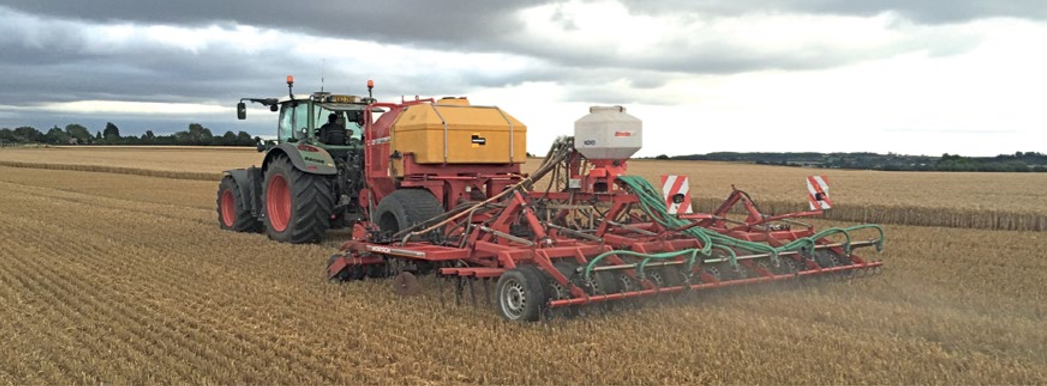
How To Start Drilling For £8K
Clive Bailye’s seed drill of choice is his 6m John Deere 750A , which has been used exclusively for 3-4 seasons. Last year, with an increased acreage, the founder and publisher of this Direct Driller magazine thought a second seed drill was necessary. Having just the one machine was a risk and in a difficult season would mean drilling was delayed. He looked around and found a good condition Horsch CO6 tine drill advertised in Germany.
Words and pictures by Mike Donovan
After delivery he rebuilt the coulters to a narrow profile so as to reduce soil disturbance. He says the tine drill is very useful driling after straw crops such as osr and also through the straw on second crop cereals.
Buying the drill from a German farmer was not particularly complicated, and provided him with a higher spec machine than Horsh sell in the UK. The seed dart tyres are much wider, and the machine is fitted with blockage monitors as well as full width front packers and also a liquid fert application system.
A sheaf of photos were taken, and Clive then asked for some of specific parts to show wear. The deal was done at under £5,000 which Clive says is the market value of these machines which are too large for small farmers to buy. Original owners like to buy new and sell when the machine is still in good condition.
Narrow tines with wear tiles
@Clive knew he wanted to make changes, substituting the Horsch tines and coulters for something far narrower, and has ended up getting his own design of tine made, which has a wear tile made from Ferobide, far harder than tungsten. The drill is on the farm primarily for osr and 2nd crop cereals drilled into chopped straw and the 25cm spacing is okay for these crops.
Comments on Clive’s on-line forum, TFF, said the drill many not be so good with beans, as the slot is a mere 12mm wide. And in barley the spacing may well be too wide as it needs to be thick. Clive points out that the seed pipe can actually be a bit wider than 12mm as it is in the shadow of the point. It would be good to have the option of using it for beans.

Above left: The cheap CO6 is being calibrated ready for its first outing

Above right: The adapted Horsch is being filled by the home built drill logistics trailer with seed and liquid starter fert.
Getting around the German instructions
The Horsch came, of course, with a control box and instructions in German. More on-line discussion revealed that English instructions were available on the Horsch website, and another explained that Horsch was sourcing some of these parts from Agton in Canada anyway. Zealman from New Zealand explained that the button marked with callipers should be held down for around 5 seconds. The menu is where you adjust the tramline sequence, valve layout and row numbers.
Ball hitch is a continental standard and provides a positive connection between tractor and drill

The Stocks Wizard has a rotor modified for Avadex which otherwise leaks everywhere
A Stocks Wizard is on the back of the drill and used for Avadex. Here again the knowledge of actual farmers is helpful. Alistair Nelson warned that the rotor and the surrounding shroud need to be changed, and he got good advice “from Rick at Stocks”. Clive has the same setup on the 750A and says that the Avadex leaks everywhere unless the modification is made. The drill was acquired and modified in 2016 and the results have been excellent.
The machine went through the residue without many problems and having the second drill has meant more timely planting. Clive has shown that moving into No-Till is not the expensive exercise so many farmers think it might be. The total cost, after modifications which included replacing all tines and coulters, was under £8,000.
Author Mike Donovan writes: we have featured a number of home made direct drills in @Practical Farm Ideas, and are always interested in seeing more. Please contact mike editor@farmideas.co.uk or 07778877514.
-
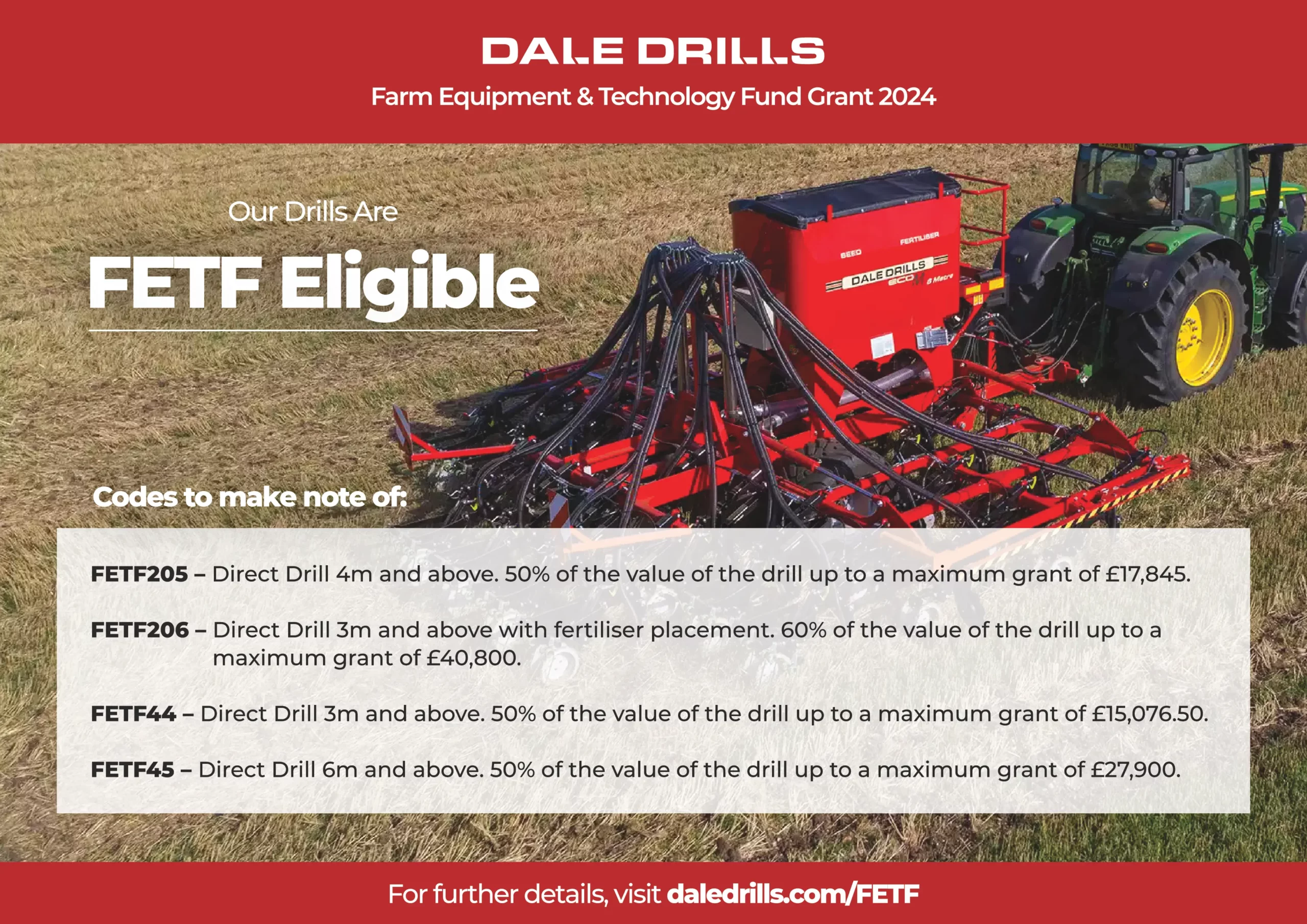
Dale Drills: Update on the Farm Equipment & Technology Fund 2024 (FETF)
Article written by Dale Drills . Come and see Dale Drills the 11 & 12 June for Direct Driller at Cereals, Bygrave Woods, Newnham Farm, Herts.
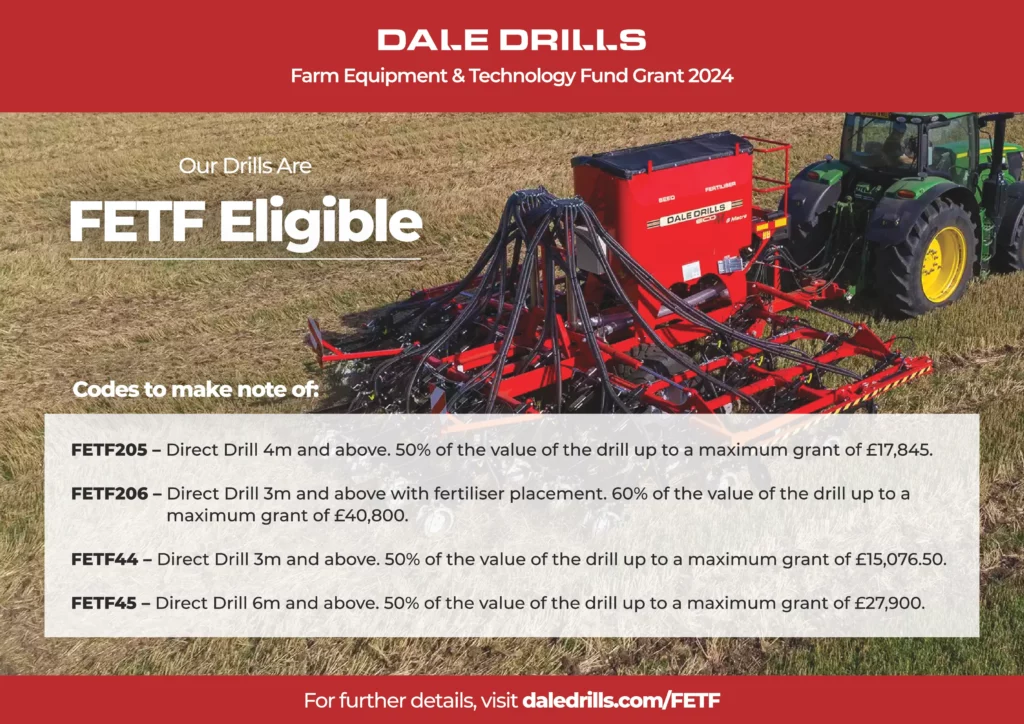
With the approaching deadline of the first round of applications for the Farming Equipment & Technology Fund (FETF) on April 17, 2024, Dale Drills is delighted by the strong interest shown in our seed drill range. While we have received numerous phone calls and enquiries, we are still encouraging further interest. To assist farmers in determining which drills in our range are eligible for specific codes, we have outlined them as follows:
- FETF205: Direct Drill 4m and above. Eligible for 50% of the drill’s value up to a maximum grant of £17,845.
- FETF206: Direct Drill 3m and above with fertiliser placement. Eligible for 60% of the drill’s value up to a maximum grant of £40,800.
- FETF44: Direct Drill 3m and above. Eligible for 50% of the drill’s value up to a maximum grant of £15,076.50.
- FETF45: Direct Drill 6m and above. Eligible for 50% of the drill’s value up to a maximum grant of £27,900.
We anticipate two more rounds of funding applications after the first round closes. We will provide an update once the opening and closing dates for these rounds are announced.
Dale Drills is committed to assisting farmers in optimising their operations with innovative equipment, and the FETF offers a valuable opportunity for those interested in integrating our seed drills into their farming practices. Don’t miss the chance to enhance your productivity and contribute to a more sustainable agricultural landscape. Contact us today to explore how Dale Drills can be a strategic partner on your journey toward efficient and environmentally conscious farming practices.

-
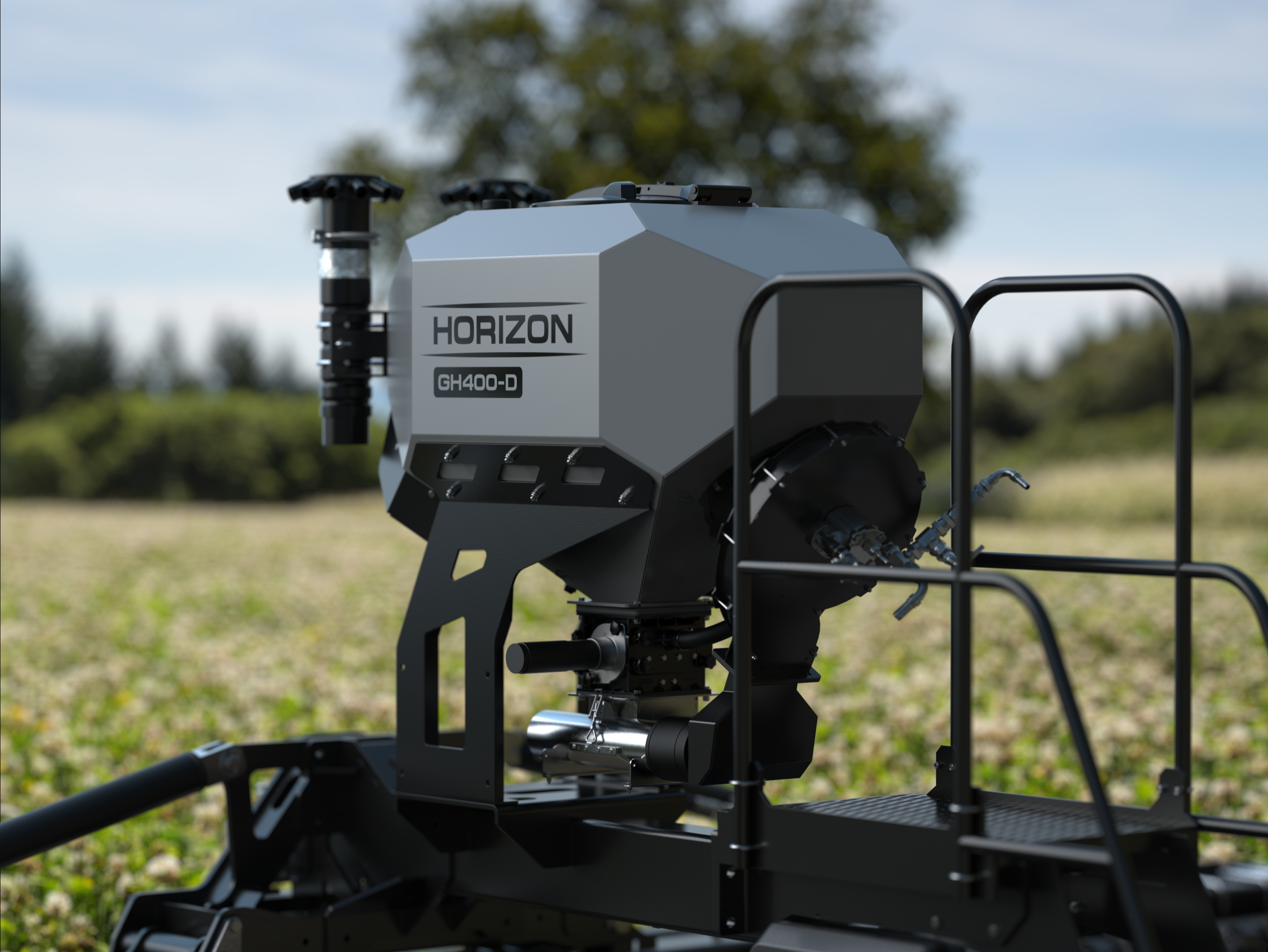
INTRODUCING THE GH400 MODULAR GRANULAR HOPPER
Article written by Horizon Agriculture . See Horizon at Direct Driller at Cereals on the 11 & 12 June 2024, Bygrave Woods, Herts
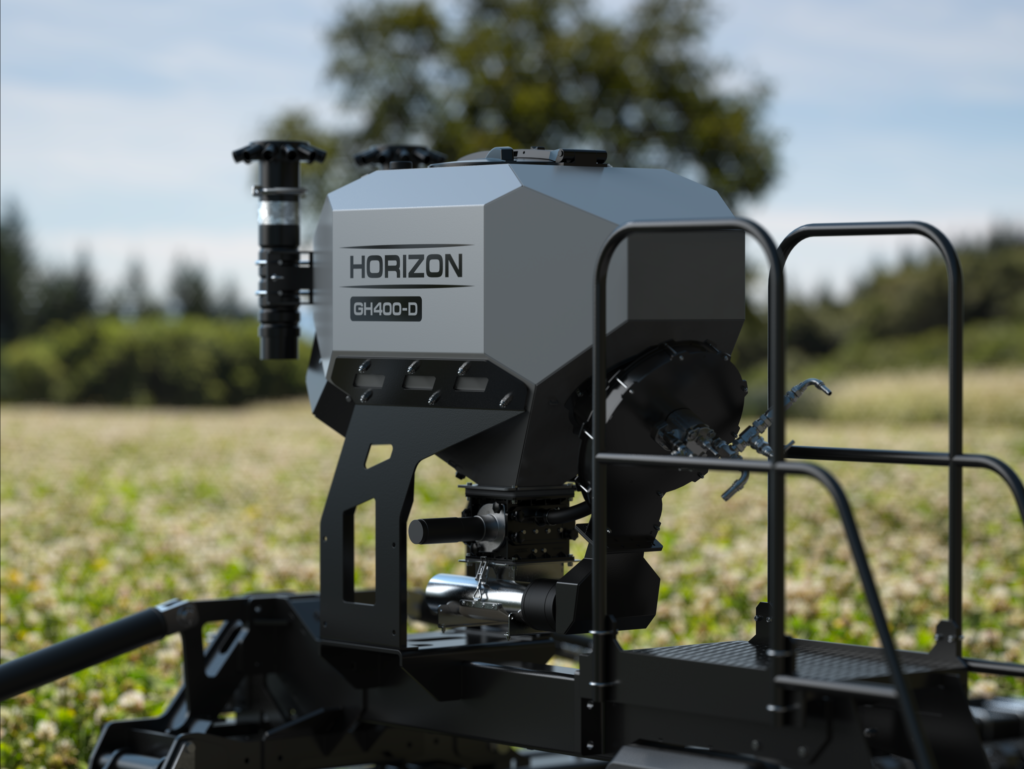
Horizon Agricultural Machinery is excited to announce our new small granular hopper, the GH400!
Extremely configurable and versatile, the GH400 is designed to work with various machines and products and features our high-performance DSX metering unit.
Designed to be as modular as possible, the GH400 can easily be combined with Horizon machines or as a standalone platform for machines from other manufacturers. It can be controlled through RDS Artemis ISOCAN Monitor or ISOBUS and features touch button calibration.
All our GH400 models have a 400L pressurised hopper and DSX metering unit with interchangeable rollers, ideal for metering micro-granular fertiliser, slug pellets, Avadex or small seeds. It can be configured in the following different specs:
- The GH400-A: Our ‘airflow’ spec acts as a third or fourth hopper for our DSX platform and upcoming 9m DSX, utilising the existing turbine and distribution system.
- The GH400-O: Our ‘outlet’ configuration features a turbine and distribution system with integrated outlets to create a completely independent seeding unit. This option is designed for machines with 4-12 outlets, and the distribution system with integrated outlets keeps the hopper extremely compact. Compatible with our PPX and SPX.
- The GH400-D: Our ‘distribution’ specification includes a turbine, injector box assembly for selective seeding and distribution heads as it is designed for machines with 6-64 outlets. This configuration can also serve as a standalone seeding unit, and is perfect for combining with a mounted drill. Compatible with our DSX and MDSX.
The tried and tested DSX metering unit found in all our GH400 models has proved extremely accurate, and the interchangeable rollers accommodate a variety of products, working widths and speeds, with 0.5kg per/ha now achievable.
The GH400’s modularity makes it a great choice for pairing with third party machinery and is eligible for 2024’s FETF207 grant when paired with a drill of at least 3m working width.
Contact us, your local Horizon dealer, or visit the GH400 webpage to find out more and learn what it can do for you.
-
Issue 27 – Contents

Inside this issue:
- Introduction – Issue 27 – Following the money
- To be or not to be
- Farmer Focus – Ben Taylor-Davies
- Is regen farming producing more nutritious food?
- Long awaited clarity for carbon accounting tools
- Farmer Focus – Tim Parton
- A sky-high revolution in crop research.
- Farmer Focus – Anna Jackson
- BYDV-Resistant Wheat
- The Challenge of Wet, Compacted Soils
- Tech defines how inputs are applied
- Achieving the potato impossible
- Farmer Focus – Phil Rowbottom
- Crop nutrition after the storm…
- Drill Manufacturer in Focus – Jeff Claydon
- Farmer Focus – John Farrington
- BASE-UK – Conference 2024 – Learning from Experience!
- Revolutionising Farm Purchases: How Farmdeals is Changing the Game for UK Farmers
- Sustainable Dairy: The Key Role of Soil Carbon
- Farmer Focus – Billy Lewis
- Farming’s fungi focus: Considering belowground to benefit above ground
- Farmer Focus – Neil White
- Agriculture has landed at an interesting turning point – where do we go now?
- Navigating the Storm: Challenges in agriculture
- Drill Manufacturer – Dale Drills
- DD Conference Area within Cereals
- Agronomist in Focus – Mike Thornton
- Farmer Focus – Andy Cato
- Changing crops in a changing climate
- Drill Manufacturers – Mzuri
- Moore Unidrill Celebrates 50 Years of Innovation with the All-New Grain & Fert Hopper Unidrill
- Nitrogen release from cover crops
- Getting to the Roots of Black-Grass’s Waterlogging Tolerance
- Cover crops for integrated weed management
- Bayer and Trinity Agtech join forces to drive regenerative practices in agriculture
-
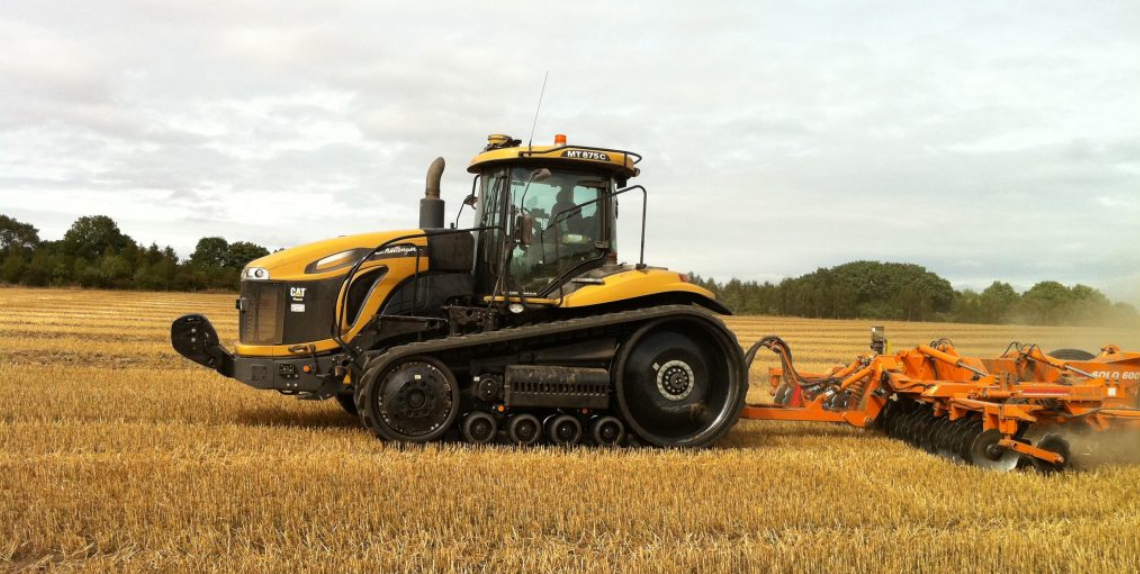
Introduction – Issue 27 – Following the money
It looks like arable movers, shakers and advisors seem to be moving away from yield, costs and profits towards the birds, bees and ecology. They’re ‘following the money’ as Warren Buffett might say. Today they are making the choice between AHL1 (pollen and nectar flower mix) at £739 / ha/year or leaving their Sustainable Farming Incentive programme at AHL3, (grassy field corners and blocks) at £590. The question is “will the marginal returns of going for the more expensive mix cover the added expense over the field corners?
Are the corners going to satisfy outcomes more easily than the pollen?” The SFI actions can extend to 25% of the farm, enough to alter investment decisions “will we need that bigger seed drill, combine or tractor when our acreage is reduced?” “Should we max out on SFI on the basis that the world grain market will continue to be well supplied with static or even depressed prices, even in a world with wars, storms, flood and drought?”
Advisors will be following the money as well. Graduates in ecology or environmental science find multiple openings for salaried work with numerous organisations which, only a few years ago, had no-one looking after this side of their business. It’s a new science with tentacles that reach back to the development of life on earth. It was not so long ago that ecology and the environment were areas of study that had a dilettante appeal that competed with art history and other esoteric areas of study. Ecology today has become mainstream and headline news, and there’s a danger it will leave the study and world of agriculture in it’s wake. Why not have both?
The agronomist who can advise on outcomes of both crop production and ecological enhancement has two vital feathers to their bow. The advisor who understands the downsides and well as benefits of traditional chemistry but who also has knowledge and experience in using bio-stimulants of all varieties is likewise one who can make the most of both nature and the continuously changing technology of agri-chems in its widest sense. Research and progress needs to continue at a useful pace, keeping on top of challenges which will present themselves as a consequence of climate change and other events.
What starts off as being a basic study leads to dozens of important interlinked pathways, all having a major significance to food production and other farming outcomes. I truly believe that Direct Driller has a lead in publishing the integration of farming and ecology in the quality of it’s articles (thank you contributors), and the quality of its readers (thank you, readers). I am always interested in contacts with both groups. mike@ farmideas.co.uk

-

To be or not to be
Never fear, I’m not venturing into Shakespeare here. Not only are my writing skills lacking, but I can’t see Direct Driller ever making it to the stage either. However, I am questioning the desire to be labelled a “regenerative farmer”. Do you want or need to be labelled at all? This is not quite weighing up life and death, as hamlet does in his soliloquy, but it is important to know what you want to be. Because wants and needs on farms soon become costs and profits.
Understanding your journey is a critical step to profitability and sustainability at a farm level. When I read or listen to our Farmer Focus writers, they often seem clear on this path. This has led the likes of Andy Cato to set up a whole brand and ethos to go alongside their beliefs, allowing other farmers to join them. Tim Parton is part of the Green Farm Collective (not to be confused with Red Tractor’s disastrous Greener Farm Commitment).
They have set out their stall and now have put measures alongside that and you must be able to measure something to make it happen. Now, you can be a Wildfarmed farmer or a GFC farmer,. you can have a label but what is the point of a label unless it benefits your business? These labels can come with benefits. All farmers in the UK can benefit from SFI payments from the government to add biodiversity to their land.
Thus moving them all along a regen journey and that comes with income. There is definitely a reason to make this step but does doing SFI make you a “regen” farmer? Some might say yes, some will say no. For me, it will depend on the farm and farmer, whether they see SFI as part of a wider journey, or just a replacement for BPS.

-

Farmer Focus – Ben Taylor-Davies
January 2024
Neurodiversity and oubaitori, 2 words that presented themselves to me towards the end of 2023, 2 words which answer a lot of questions to many of my life’s struggles, thankfully something that seems to have been put well behind me since finding regenerative agriculture and realising this would cure my mental health issues.

Typically, I had to find the answers to my problems before they found me, however I spend my farming life doing the same. Neurodiversity is now quite incredibly the name given to those suffering from anything on the autism spectrum, ADHD, Dyslexia and or Dyspraxia. As a farmer I have 3 times more chance of being neurodiverse than the rest of the population…. It took me over 30 years to realise this is a good thing and in farming a great thing.
Historically a farming family would have many children, with the academics of the family heading off to the city to work and those with less academic ability to remain home and use their more practical brain to farm. Natural selection then meant this was kept as a trait as farms were handing down through generation after generation.
Farming throughout history was a problem-solving industry, without the ability to reach for packets, cans, bottles, bags and syringes the ability to think laterally was a real asset, this kept these special minds occupied day and night. However, take away the need for the problem solving with the green revolution, a world of advisors and you still have a brain that is hugely active and needs feeding, often with all the things then beyond control and why mental health issues (in my view) is so high in agriculture.
Oubaitori is the Japanese idea that people, like flowers, bloom in their own time and in their individual ways. Education for myself was a struggle, certainly until A levels when my geography teacher Mrs Miles decided to change tac on my teaching and proceeded to bet I couldn’t do something, the result was an A in A level geography and then a BSc in Geography at Liverpool University. However, what I discovered was education for myself only became interesting and exciting when I was learning about something I felt stimulated by.
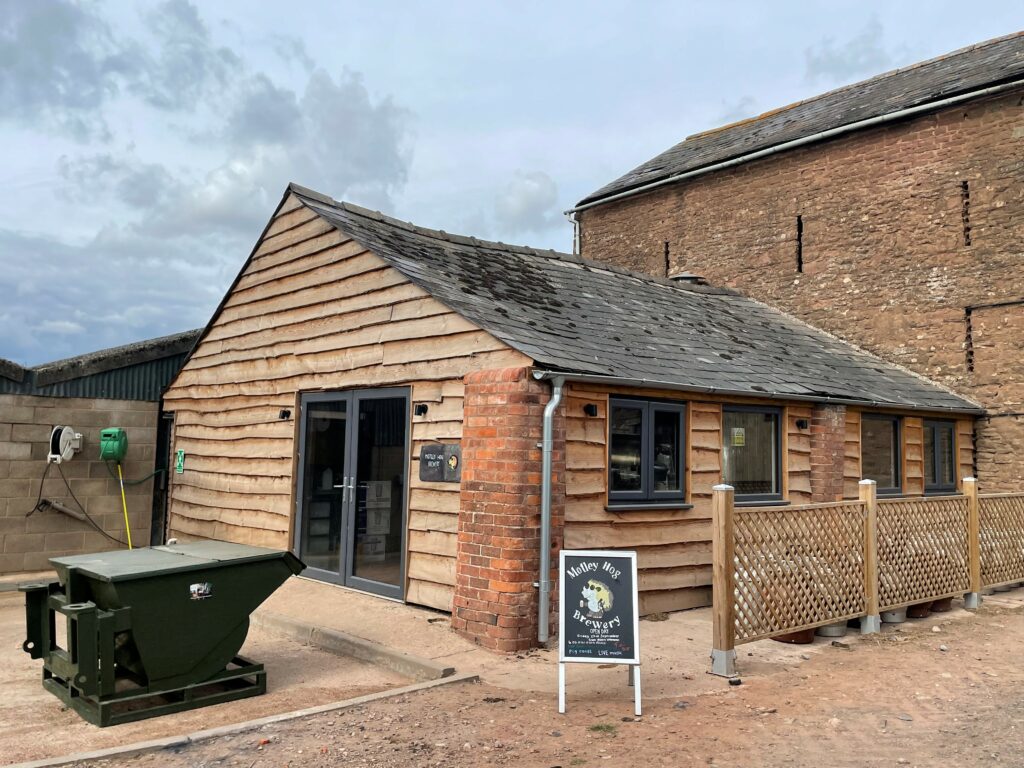
I think many farmers I speak to have very similar sentiments when it comes to both Neurodiversity and oubaitori, what a great asset to implement a sustainable future for my own farm?! Put my mind to work with something that interests me and with it drive profitability.
Lunchmoney Lewis even sang about them “Bills” something we as farmers need to focus on far more than we do, it’s easy and even lazy just to pile into the agchem industry, yet rarely do I see a pile on into the veterinary industry, insurance, banking, machinery industry and even auctioneer markets, all of which have based their industry extracting what they can from our profits, it’s a real issue and something we are concentrating on at Townsend Farm (Ross-on-Wye) where we farm 220Ha of deep river silt or the red sandstone loam over sandstone the area is most famous for. As I’ve mentioned in so many podcasts, farming is essentially taking 3 free things (Sunlight, precipitation and carbon dioxide, putting them through soil) and making profit, yet somehow, as an industry most farms are in debt…….
Agflation is frightening, my grandfather retired when he bought a Massey Ferguson 135 (which we still own) in 1965 for £885 purely on the basis that he couldn’t see a future fro farming if the cost of a tractor was to go north of £1000. Allowing for inflation the £885 would now equate to £14,283.76, with all the modern technological advances, how much really have we gained? Our Ford 7810 (95hp) during the 90’s ran a 4 furrow auto reset Kverneland plough, it would now seem driving around that between around 200hp seems the norm for a 5 furrow plough – what has gone wrong?

Dopamine is the simple answer, the feel-good drug our body releases as we prepare to and then complete the purchase of a new item “The reward drug” from retail therapy for farmers is often used in the absence of this drug being released if you manage to solve a problem on the farm without using the ‘industry standard’ the latter of course being far cheaper! I am not saying the drive for new technology shouldn’t be sort after, what I am saying is the machinery manufacturers use this dopamine drug to lure you into the showroom and you leave feeling great after parting with a small fortune…
“Intensifying diversity simply” is the 3-word motto of the farm, with the disappearance of BPS and the obvious need to demonstrate to the general public that any money they are being taxed for to give to farmers should be earned for the benefit of everyone as public goods. There seems to be real reluctance to embrace SFI for everything it is along with other schemes aimed at providing support to farms that now offer a financial incentive to protect their main asset (soil) because without this support many are happy to see it literally flow out of the gateway…. Soil is simply like a bank account, if there is less going in than going out you are in debt, when you pass how much debt are you leaving your kin? How many farmers reading this can honestly say they have more soil today than when they began farming? I’ll be brutally honest – definitely not me!
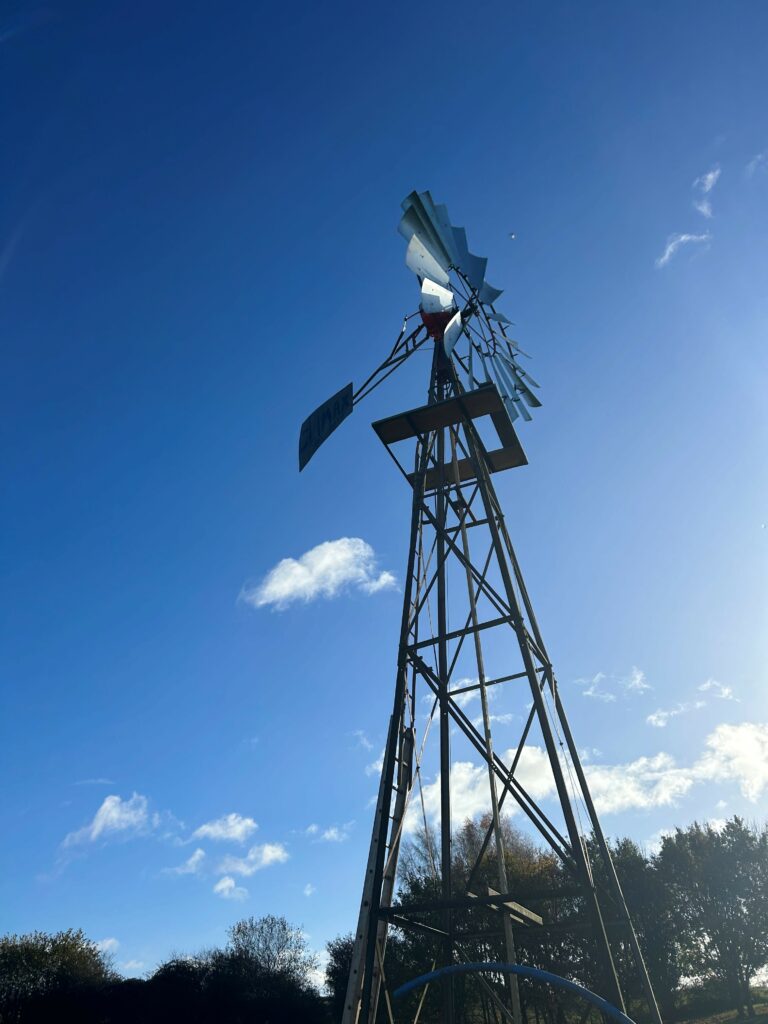
Fighting the bills has become our major focus on the farm, our latest project has been the resurrection of our wind powered water pump which fell into disrepair in the 1960’s and sat there as a relic for so many years, often meaning to push the tower down and send it off for scrap, we now have part A of our energy sustainability project up and running. A FIPL (Farming in protected landscape) grant helped us out a bit towards the cost of having the mill restored and to see the dopamine oozing out of me as the wind turned it as it started pumping water for the first time in 60 years is an understatement, but like anything on the farm this is the just the beginning. The water will be pumped to large storage tanks up at the farm, where of course it will provide water to ourselves and the livestock, but will also feed the solar powered electrolysis unit to split the water into hydrogen and oxygen. The hydrogen to power farm vehicles and the farmhouse heating system and the oxygen used in the compost extraction system. Can we be one of the UK’s first fossil free farms?
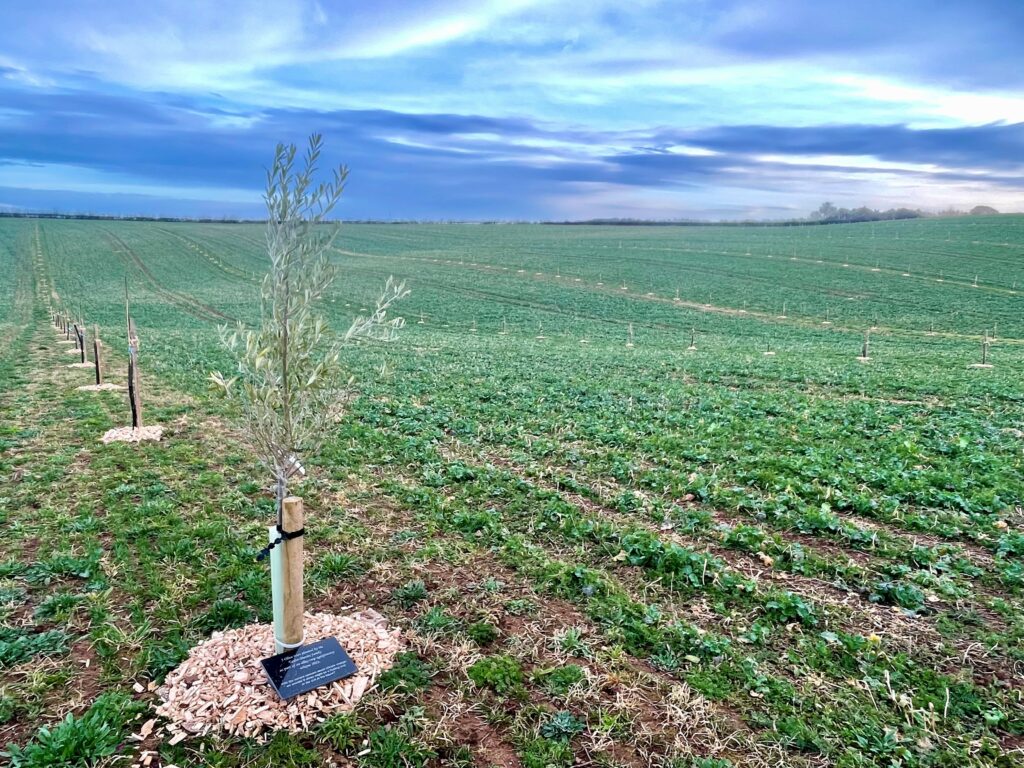
The Brewery on the farm is another example of our circular economy way of thinking, produce malting barley, have it malted, sell it to the brewery, use it for 4 hours and then feed the brewers grains to the few Wagyu cattle we now have, combined with their ability to swallow up the waste beer and the introduction of a rotating cattle brush as a massager – will we be producing A5 meat within a few years? Time will tell!


-

Is regen farming producing more nutritious food?
Can how you grow crops impact on the nutrient and health value of food? It’s what farmer and doctor Hannah Fraser is trying to find out on a Nuffield Scholarship
By Mike Abram
For a long time there has been a suspicion that how you grow food will determine its nutrient status and ultimately impact how healthy consumers are. It’s a claim some in the organic farming sector, and more recently regenerative farmers have tried to make but is there evidence to back that up?
That’s what motivated first generation farmer Hannah Fraser to investigate the topic for her Nuffield Scholarship.
“Five years ago, I knew very little about food production,” she says. That was the moment she and her husband Alex took on farming the land around the family home at Denby Hall Farm, near Huddersfield in Yorkshire.
Deciding to farm organically, Hannah and Alex, the pair have embraced practices designed to restore soil health as quickly as possible.
Linking how farmers can impact the health and nutritional value by how they farm was a natural step given Hannah’s day job as a medical doctor at a Leeds hospital.
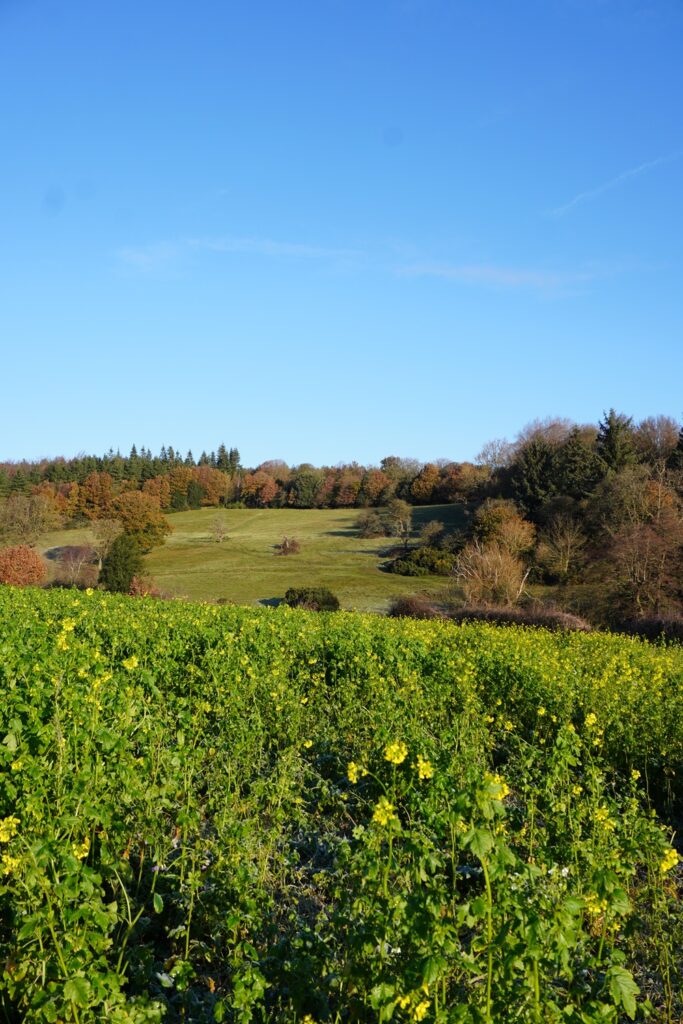
“I’ve learned a lot working in the medical profession,” she says. “Sadly we have a real issue in this country with chronic diseases, such as diabetes, high blood pressure, dementia and heart disease. They don’t go away easily, often requiring a lot of medication and follow up, impacting quality of life.”
In the UK, she says, just under half the adult population suffers from at least one of these conditions, and while life expectancy is a reasonable 81 years, the age to which we’re expected to live well with no medical problems is only 63.
“What’s more worrying is these numbers are in decline, so our health is potentially getting worse.”
A lot of research shows the importance of food and diet in reducing disease risk, but, while nutritionally dense food is far from a new concept, much less research has been conducted linking how food has been grown to nutrient richness and our health.
There are essentially three components to food that determine nutrient density – macronutrients, micronutrients and phytochemicals.
Macronutrients are the big things – proteins, carbohydrates, fats and fibre, Hannah explains, while micronutrients are the vitamins and minerals present in small amounts. Phytochemicals include thousands of plant-made chemicals, such as beta-carotenes, anthocyanins, phenols and flavonoids.

“Macronutrients often get talked about more in dietary recommendations, but I think it is the micronutrients that can really make a difference to our health. We can’t make these ourselves, so they have to come in our diet.
“In high income countries, where people are relatively calory-secure, just under half of children under the age of five and half of women of reproductive age are deficient in at least one of these micronutrients, so how nutritious our food is could make a real difference.”
Research is also finding phytochemicals have remarkable effects in the body including anti-cancer properties and reducing inflammation, which can be an important component of those chronic conditions.
“It’s why we get told to eat a variety of fruit and veg; eat the rainbow.”
But there are a huge number of unknown phytochemicals in food, which have unknown impacts of our health or how farming systems influence their levels, she adds.
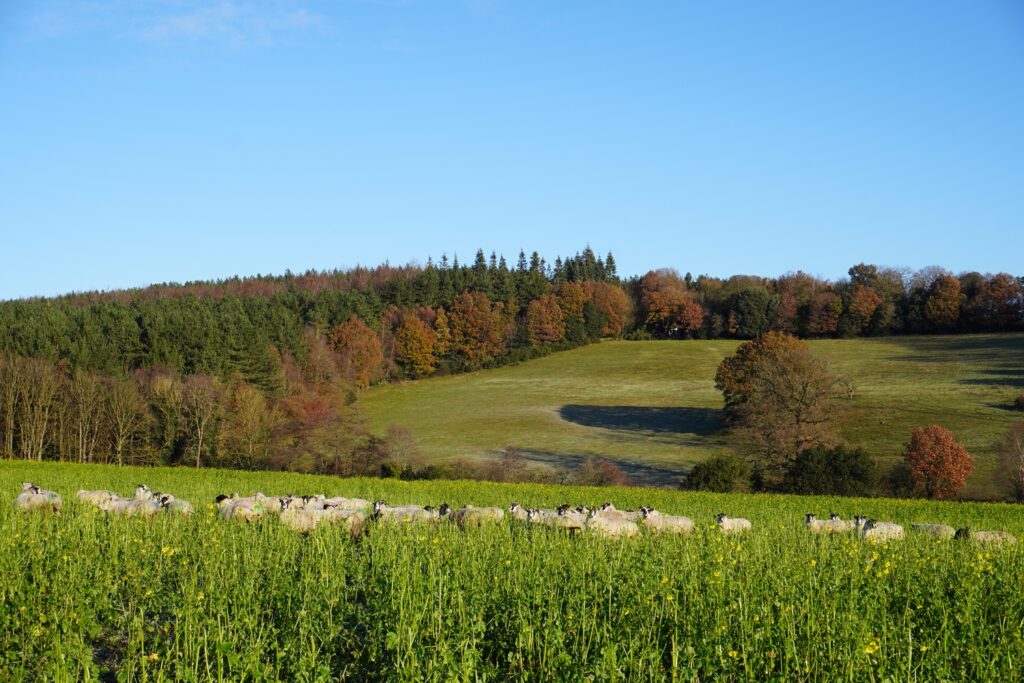
So has the nutritional levels in food declined? Some data suggests it has – a group of scientists compared UK government data between the 1930s and 1980s in 20 vegetable and found 19% lower calcium, 35% less magnesium, 22% iron, 81% copper and 14% less potassium, Hannah says.
“Similar findings have been found in US and Finnish data, although there is criticism of this data. Testing will have improved since the 1930s, and there could have been errors, such as tiny traces of soil left on food which would have made the nutrients levels higher.”
What about testing today’s food and seeing if it varies? That’s what US-based Bionutrient Food Association is hoping could be possible with a handheld device, Hannah says. “To calibrate the device they’ve been taking food samples from across Europe and the US to see how the amount of nutrients varies.”
And the answer is in some foods it can vary a lot. For example, in kale the amount of calcium can vary between 15% and 40% of the recommended daily intake, so at the lower side you would have to eat three times as much to get the same amount of calcium.
The same applies for some other nutrients and vegetables, while similar analysis for polyphenol and antioxidant phytochemicals shows wide variations in some fruit and veg.
“We can’t say what the health impact that is as we don’t know how many phytochemicals you need to be healthy.”
So can we produce more nutrient dense food through changing the way we farm? That’s what those farming using regenerative or organic practices hope, and there is some evidence starting to emerge that might be the case.
Geologist and author David Montgomery and partner Anne Bikle, a biologist, have set up a preliminary trial comparing 10 regenerative farms with conventional counterparts in the USA.
Early trial data suggests, for example with cabbages, the regeneratively farms are producing food with more nutrients. “For vitamin K, 30% more of the amount that you need in a day was in the regenerative cabbage compared with conventional, and 10% more vitamin C.
“In wheat and oats, there was quite substantial differences in mineral content, but it’s just 10 farms so we can’t draw conclusions yet, and shows what a study looks like.”
Other studies have shown higher amounts of ergothioneine, which is produced by fungi and nicknamed the longevity vitamin because it seems to prevent ageing, is found in soybeans and oats produced in a no-till system compared with plough-based establishment.
“It’s an interesting example of how a healthy soil might be providing different compounds,” Hannah suggests.

Or there’s the study showing higher abundance and diversity of beneficial microbes on salad grown in soil compared with grown in a sterile vertical system. These microbes might be helping to populate our gut microbiome, keeping us healthy.
Breeding varieties with higher nutrient density is also possible, as shown by Harvest Plus, a group working in developing countries using conventional breeding to increase iron, vitamin A and zinc in crops.
“Could we breed a wheat that’s high in zinc, iron and copper?” Hannah asks. Already in Finland a programme to apply a foliar selenium fertiliser to wheat has helped solve a deficiency issue in its population.
In livestock agriculture, researchers have found the amount of forage in dairy diets balances the ratio of omega 6 to omega 3 fatty acids in milk to around 1:1 when the animals are fed 100% of forage, compared with 8:1 when there is minimal forage in diets.
This is important as in modern diets we’re consuming around 16 times more omega 6 than omega 3 and scientists think this could be promoting inflammation causing heart attacks, Hannah explains.
“So 1:1 is more in line what might be healthier for us,” she says. “And the same 1:1 ratio has been seen with grass-fed beef compared with 10:1 for cattle finished on a mixed ration.
“There were also a lot more phytochemicals in grass-finished beef.”
Those research findings are giving confidence to Hannah that there is real evidence that different farming techniques can produce healthier, more nutritious food, although more is required and will be needed to convince the public and for policy makers to put in the right incentives for farmers to switch practices.
“We’re in the early days of recognition of the link between farming and health,” she says.
Harking back to a quote in 1943 by Lady Eve Balfour, a British organic farming pioneer, that spoke of the connection between health and correct soil management and the need for any public health system to be connected to soil fertility, Hannah hopes that farmers will be recognised for the important role they play in public health.
“Maybe one day like today when we’re starting to be paid for ecological services, we’ll start to be paid for health services for the role we play in producing nutritious food,” she concludes.



-

Long awaited clarity for carbon accounting tools
After a year-long investigation, Defra’s report: ‘Harmonisation of Carbon Accounting Tools for Agriculture’ is providing much-needed guidance on appropriate standards for carbon reporting.
Direct Driller spoke to Dr Emily Pope from Trinity AgTech to find out what this means for farmers.
A new era for carbon accounting: From the ‘Wild West’ to the ‘Collective Era’
Emily explains that before Defra’s report, the landscape for carbon accounting was unregulated with no clear direction or guidelines.
“Many people called this the ‘Wild West’, however, that era and its financial and environmental futility is shifting to a new era.
“This new ‘Collective Era’ is defined by a movement towards global standards, protocols, rigour, and well executed methods as well as continuous innovation, trust, credibility and collaborative learning.
“All these parameters will help to deliver robust supply chains, environmental progress, and prosperous rural communities,” says Emily.
Detailing the positive implications of this for arable farmers, Emily adds: “We can expect to see farmers and the whole supply chain starting to earn fair and full recognition and reward for trustworthy and credible decision-making that delivers efficient environmental progress in tandem with food production.”

Why assess a farm’s carbon footprint
Emily stresses the inevitability of credible and trusted carbon footprint assessments for all farms, not least because of the increasing attention to the laws and regulations against greenwashing and simple box-ticking. She is also keen to highlight the wider opportunities associated with robust and reliable natural capital navigation.
“The push of carbon footprinting from the supply chain is unavoidable; we’re seeing it increasingly in the livestock sector and other sectors will follow.
“I’m therefore urging farmers keen on better economic and environmental outcomes to remain firmly in the driving seat; this means using reliable software to ensure they have the most accurate data possible, on not only the carbon they emit but also the carbon they sequester,” says Emily.
She explains that there is a big difference in emissions and sequestration.
“All farms have inputs, it’s unavoidable, but they also have trees, hedges, and other natural assets on the farm.
“Often, these environmentally beneficial features are overlooked in carbon accounting.
“This oversight can unfairly portray farms as having a higher environmental impact by focusing solely on inputs and emissions.
“However, natural assets on farms play a crucial role in offsetting the farm’s carbon footprint by absorbing carbon dioxide, essentially mitigating some of the emissions from arable operations,” says Emily.
She adds that recognising and accounting for the positive environmental contributions of maintaining natural habitats on farms is essential.
“This allows farmers to demonstrate the comprehensive environmental stewardship of their operations, challenging the narrow focus on emissions and highlighting their efforts in promoting sustainability.”
If farmers are asked to undertake a carbon assessment, Emily advises that the carbon accounting tool should be critically assessed. “Outdated ‘first generation’ calculators are still being recommend by some businesses, including a few consultants, but these tools produce falsely simplified results that undervalue natural capital assets.”
However, Emily adds that Trinity AgTech’s Sandy is the only tool which complies with the most up-to-date recommendations, as per Defra’s report, and also supports on-farm decision making helping to drive efficiency savings.
“Measuring and benchmarking a farm’s carbon footprint is an important part of decision-making and its value shouldn’t be underestimated.
“By assessing a farm’s carbon footprint on a field-by-field basis, farmers can start to understand what’s driving the footprint and make management changes to lessen it.”
There is evidence that lower carbon footprints are associated with higher efficiencies, which are linked to cost savings.
“In the UK, emissions from arable production are generally between 1 and 4 tonnes of CO2 equivalent per hectare,” says Emily.
She adds that the emissions intensity per tonne of crop produced can vary widely.
For example, emissions from high yielding crops, such as forage crops, can be less than 100 kg of CO2 equivalent per tonne of crop. Whereas emissions from crops with lower yields, such oilseed rape, can be more than 700 kg of CO2 equivalent per tonne.
Without undertaking an assessment, Emily notes that many businesses would be unaware of their output.
Worse still, they could be using a tool which is not fit for purpose, which could potentially be giving unreliable data and misguiding decision making.
Public and private investment around natural capital is also growing, but farmers should consider these opportunities with diligence.
“Farmers could do enormously well for themselves and the supply chain to properly understand the extent and the value of all of their natural capital assets, from carbon through to biodiversity, and be confident in the credibility of their assessments before embarking on any arrangements.
“This is the key to recognising the true value of natural capital using reliable, comprehensive and accurate software.”
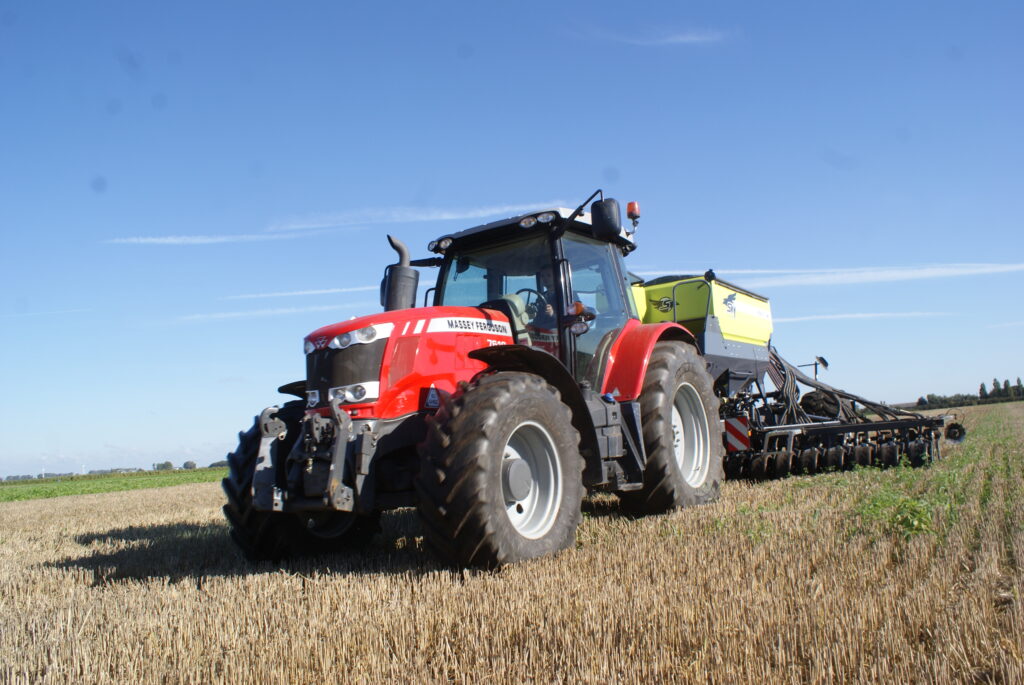
Choosing carbon accounting software
Emily explains the landscape of carbon assessment software is complex, but fortunately Defra’s report has finally offered clear guidance and direction.
“Given that farm-level carbon accounting is currently completely unregulated, there is significant divergence in calculation methodology and the resulting information.
“This has reduced trust, stalled environmental efforts, and prevented proper recognition and reward.”
Defra’s report started by reviewing 81 global carbon calculators, analysing in detail the six most relevant and suitable for UK farming.
Reading the report we clearly see that only one tool stood out as being uniquely fit for purpose, Emily explains it was Trinity AgTech’s Sandy.
“This was in part, but not solely, due to Sandy being the only tool to align with the recognised standards recommended within Defra’s report, including ISO 14064:2, ISO 14067 and the draft GHG Protocol Land Sector and Removals guidance, supporting the Science Based Targets Initiative (SBTi),” she says.
Sandy – a new category of carbon accounting software
Having recognised the extreme pitfalls of ‘first generation’ carbon calculators that are often used to assess farm-level carbon, Emily explains that Trinity AgTech has pioneered food and farming’s ‘Smart Precision Navigation’ category of software.
“Sandy is in a complete league of its own and is uniquely positioned for the new ‘Collective Era,” she says.
“This is because the tool is optimised and built from the ground up to focus on continuously delivering increasing value by leveraging cutting-edge proven insights and methods in science, technology, assessment standards, and farming.
“It uniquely provides farmers and key sector stakeholders access to distinctive and relevant science methods, services and platforms that are evidenced, credible and trusted, adding value throughout the supply chain.”
She highlights that this development represents a significant leap forward in agricultural technology.
“By focusing on smart precision, continuous innovation, and comprehensively addressing the complexities of modern agriculture, we’re not just keeping pace with the times and the assessment protocols – we are delivering a new standard for the future.”
Questions to ask before choosing carbon accounting software
If farmers are asked to use a specific carbon accounting tool, Emily encourages them to ask the following questions to ensure the enterprise is not being penalised and disadvantaged:
- Does it align with the standards recommended within Defra’s report, these are ISO standards 14064:2 and 14067 and the draft GHG Protocol Land Sector and Removals guidance which is supportive of the Science Based Targets initiative (SBTi)? This is a must to produce trusted and reliable data.
- What data is required and how does the tool handle assumptions? This effects the accuracy of the output and the ability to identify specific areas for emissions reductions.
- Does the tool provide guidance and support for understanding and interpreting results? Given the complexity of carbon accounting, the tool must offer clear support to enable farmers to make informed decisions about reducing emissions and enhancing carbon sequestration on farm.
- Handling of low carbon fertilisers: the Defra report discusses the complexity of emission factors and how they vary between calculators, particularly with manufactured fertiliser and organic manures.
- Does the tool fully represent the farm’s activities: a tool should comprehensively represent all farm activities, including emissions and sequestration.
- Does it allow for carbon sequestration on the farm? For example, all the great natural habitats and features which are absorbing carbon such as trees, hedgerows and permanent pasture.
- Does it have the capability to account for natural capital assets beyond carbon, such as biodiversity, soil health and water quality? These assets also hold significant value.
- Does it offer scenario planning functionality? This can help plan decision making and reduces the risk of management changes.
Sandy demonstrations available this summer
Trinity will be offering Sandy demonstrations at several shows and events this summer.
- Scottish Land & Estates Annual Conference 2024, Tuesday 21 May
- Green Farm Collective Regenerative Agriculture Conference 2024, Wednesday 22 May
- The Suffolk Show, 29 & 30 May 2024
- Groundswell, 26 & 27 June 2024
Farmer case study: Michael Kavanagh, Church Farm
First-generation Shropshire farmer and founder of the Green Farm Collective, Michael Kavanagh, explains how he set out to create a sustainable and profitable business using regenerative farming principles when he began farming at Church Farm eight years ago.
“After starting out using a strip-till system, I became interested in soil health which led me to consider how I could farm sustainably without using off-the-shelf chemicals.
“I realised that there was another way to farm as opposed to the conventional practices I’d always followed,” says Michael.
The farm now follows a zero-till system; insecticides and plant growth regulators are no longer being used and in the last two years only one fungicide has been used across the entire farm.
However, he notes that if the ground isn’t ready for no-till then the results will be affected.
“For example, on a large area of new land we’ve stepped back to strip till because the land is simply not ready for a zero till system.
“Implementing a zero till system wherever possible is a big change. By not moving the soil, we’re keeping all the carbon locked in, with no impact on yields.
“Church Farm is also really pushing the boundaries of what’s possible with on-farm changes including zero use of P & K bagged fertiliser,” says Michael.
“We’ve also minimised our fuel usage as a result of zero till. During drilling, we’ve been using around five litres of fuel per hectare which is a miniscule amount for on-farm work.
“Nitrogen use efficiency has been hugely improved through the work we’ve been doing on farm.
“Nitrogen is one of the biggest killers on carbon calculations, so being able to improve the efficiency of this has been a great achievement.
“We’ve also extended our rotation and included cover crops which has demonstrated huge benefits.”
Michael explains that as part of the Green Farm Collective, he was looking for a partner to be able to quantify the work they were doing to improve their sustainability.
“We knew we were doing the right things on-farm, in terms of carbon and biodiversity, but wanted to be able to quantify it.
“We explored various options and Trinity AgTech had the best understanding of the practices we’d adopted and the most robust science and analytics in Sandy.
“The agriculture sector is in pioneering times at the moment and there’s going to be a lot of change in the coming years, so it was important to find a navigator we could rely on and trust.”
Key recommendations from Defra’s Harmonisation of Carbon Accounting Tools for Agriculture report
Defra’s recommendations for supporting the harmonisation of farm-level carbon accounting are as follows:
1. Industry and HMG to clearly define what a farm-level assessment is, how it is going to be used, and what parts of a farm business should and should not be included.
2. Calculators to align with the requirements of the latest standards and guidance – currently GHG Protocol standards (including the upcoming Land Sector and Removals guidance), ISO 14064 and ISO 14067. Industry and HMG to provide guidelines to support a standardized way of applying these in an agricultural context.
3. Calculator providers to regularly review and update calculators to account for changes in scientific knowledge, carbon accounting methodologies and new emission factors.
4. Calculators to comply with the latest IPCC guidance (currently IPCC 2019) and use those calculations and emission factors as defaults where Tier I approaches are used. Where appropriate, calculators to use Tier II and Tier III calculations where robust emission factors and methodologies are available, such as emission factors created for the UK GHG Inventory.
5. Calculators to use emission factors from an agreed set of robust databases for embedded emissions in fertilisers, feeds and fuels. Industry to support the development of appropriate emission factors for embedded emissions in purchased livestock.
6. Calculators to present outputs in compliance with the latest standards. Industry and HMG to define consistent disaggregated output categories for use by all calculators to facilitate understanding of emission sources.
7. Calculator providers to build user confidence through transparency of approach and third-party verification of the alignment of calculators to minimum standards





-
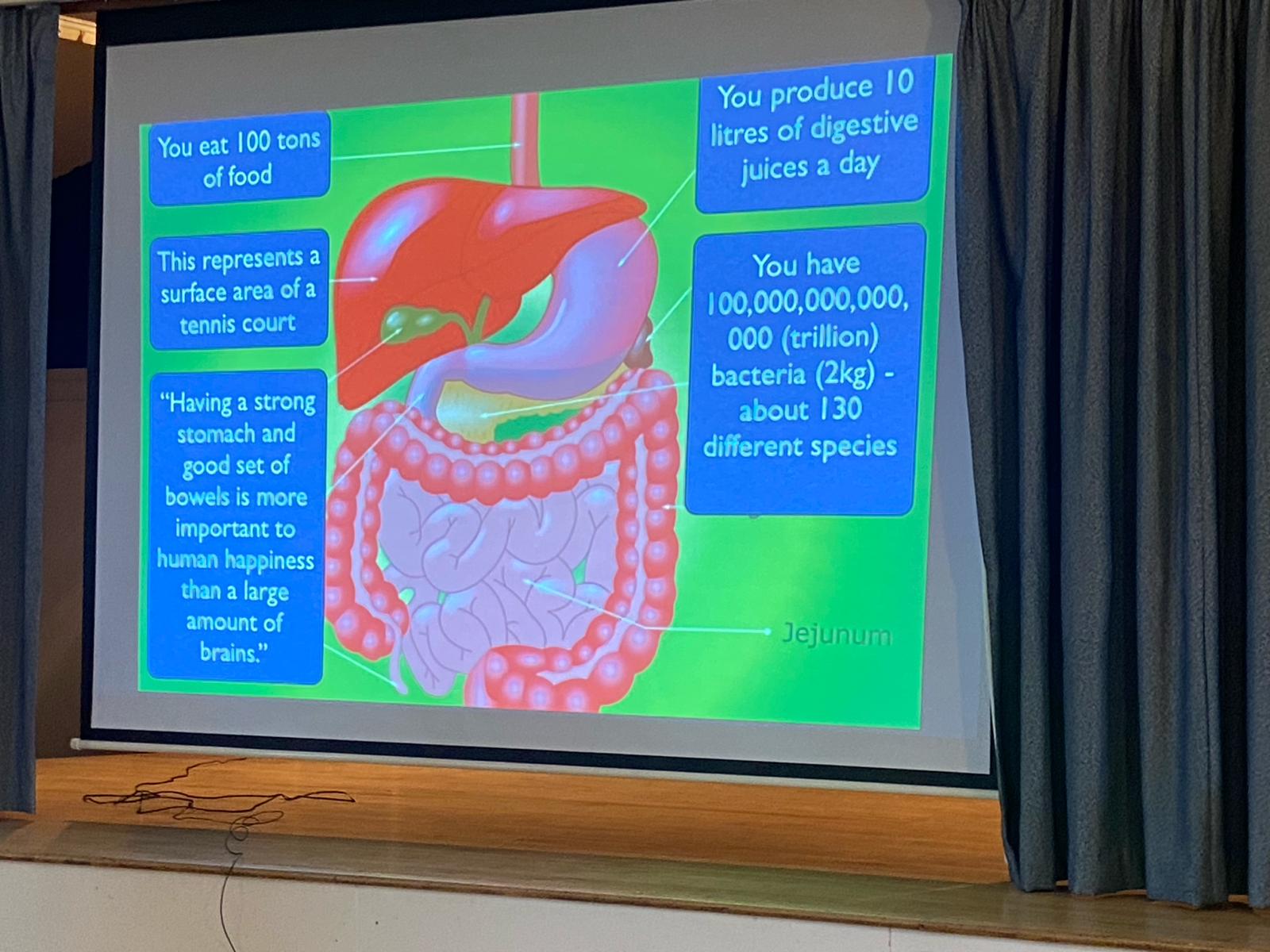
Farmer Focus – Tim Parton
February 2024
Water, water everywhere! I bet it turns off just when we need it!
What an Autumn/Winter! The rain keeps coming, which makes you wonder if it will turn off just when we rely on it. On a positive, it is wonderful to see how well my soil copes with these extremes, with fantastic infiltration rates and organic matter levels rising yearly, I can store a lot more water than I used to, which was always one of my aims.
At the time of writing, we have just had yet another storm, which on a positive gives me the time to go and speak at the Scottish Agronomy Technical Conference (there is always a positive, we just have to look for it). To date I have applied some calcium to winter crops, as calcium is the King of nutrients to me and is often overlooked and compared with pH – pH being potential hydrogen. Plants are weak and open to disease when calcium levels are low due to bacterial and fungal attack. It is needed for cell signalling, cell division and cell wall strength. Roots will cease to develop without calcium and if you have a low fungal soil, it can be sign of low calcium, which is why it is so important and why I refer to it as the King of nutrients! Calcium is also the carrier for many other nutrients.
The farm looks very well overall, with lots of potential going forward, but as we all know, things can change so quickly with the weather patterns we are now having to contend with. We have joined the SFI as it brings a nice income onto the farm which is gratefully received. It saddens me to hear many farmers looking at it as just another subsidy and only doing the bare minimum to obtain the cash or looking to put a legume fallow in the Spring, knowing full well it won’t meet the requirements of the scheme. Wherever I speak in the world this scheme is envied by conservation regenerative farmers: the fact that we are being paid to improve the health of our soil, which is any farmers most valuable asset, should be applauded in my opinion. It is quite ironic for me that I always set out to be able to farm without subsidy, when now I am being rewarded for the way I wanted to farm all along. I am not a fan of farmers being encouraged not to farm, as I feel it is such an oxymoron to give ourselves a pat on the back at how green we are being, only to import our food from another country! Robbing their water and resources in order to meet our demand for food, plus the carbon footprint in getting the food here. I have proved that I can still produce food, of better quality than what is imported, I might add! While healing the planet in which we live, putting the carbon back where it should be stored in our soil, to feed the underground livestock. By not producing our own food is just moving the problem elsewhere and we should be hanging our heads in shame at that.

Wood Vinegar will be featuring a lot in my application programme going forward, as it is a fantastic carbon source, which I have seen to improve root growth, leaf etc. Care has to be taken on rates, as it is with all products, balance is everything. What I have seen so far is very encouraging and I will be running more trials this coming season! Trials are always the way forward, as I like actual results and returns before rolling out across the whole farm.
I have had a very busy Winter (Winter used to be a time to replenish my energy levels for the coming year) speaking the length of the UK, which I have thoroughly enjoyed and met some fantastic farmers and people. My website https://www.timpartonfarming.com/ has members from around the globe and is keeping me busy answering questions and helping people on their journey of discovery in the wonderful world of conservation regen agriculture. We all have so much to learn, but farmers have very similar problems wherever they are on the planet.
We have had a very busy few months within the Green Farm Collective, putting together biodiversity/carbon deals and the one where we have been focusing a lot is to be able to sell certified regen produce. This has taken a great deal of work and one which we are very proud of, with our first load of wheat due to leave very shortly, giving at least a £20/ton premium back to our members, be it milling or feed wheat. We are now starting to focus on malting barley as we are having Maltsters getting in touch with us. Demand is escalating, but I would urge everybody to stand together on this one as we deserve a premium for our produce when we are doing so much good for the planet in which we live. I find once you explain the story behind Regenerative Agriculture people want to buy in and be part of that story and will happily pay an extra five pence on a loaf of bread; but the story needs to be told and the produce has to be genuine, otherwise it will get swallowed up and spat out with no premium to the farmer and no achievement for the planet in which we live. It will all just become green washing! This is why we have a set definition within our membership of what Conservation Regenerative Agriculture is and one which will be added to, in order to achieve the ultimate, regenerative planet.
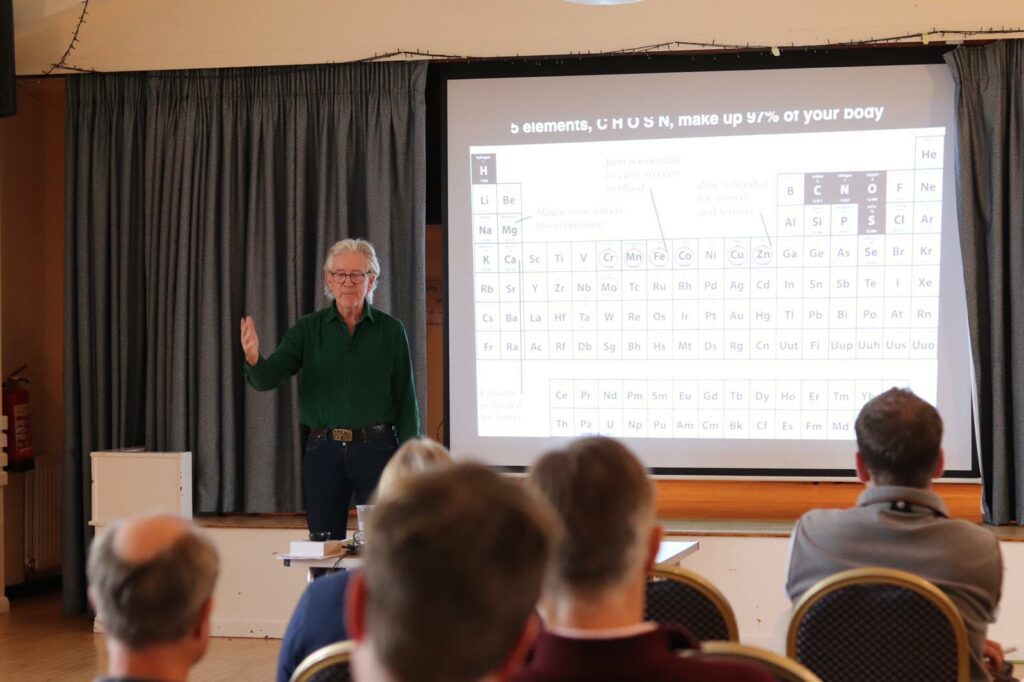
Green Farm Collective have our annual open day on May 22nd which is free to members, and any non-members who want to attend can purchase tickets (see the advertisement within Direct Driller). We have a great line up of speakers and will be updating attendees on our progress with sales of produce, carbon and natural capital.
On a last note, we organised a great workshop with Dan Kittridge from the Bionutrient Food Association and Patrick Holford, founder of the Institute of Optimum Nutrition.
Dan spoke in the morning, talking about his work with the Bio-meter which measures the nutrient richness of the food we have produced. He had some fantastic results with the main theme being that a healthy soil produced the best food, regardless of the system, which all comes back to the microbes within and keeping them well fed: healthy soil is everything. The other interesting results were from beef produced of herbal leys, which produced by far the best meat, compared to cereal fed beef. To me, this is just common sense, as ruminants were never designed to eat cereals, which is why they burp and fart such a lot when being fed a cereal ration. as they have so much indigestion. Whereas a nice herbal ley gives the animal so much choice, that they can get the nutrients they desire in order to keep themselves healthy and at peak production, with that health then being passed onto us. My family and I have been eating grass fed beef for many years now, which I buy from a good friend of mine, Martin Howard from Northcote Farm in Devon, which arrives in perfect condition, frozen, with next day delivery. Nothing beats the taste.

Patrick Holford spoke in the afternoon. He has helped many people including me with mental and physical conditions over the years using nutrition. He spoke on the prevention of Alzheimer’s and dementia, which was a fascinating talk, making the connections with healthy soil, as food should be thy medicine. Like me, Patrick recommends supplementing nutrition with additional supplements, when disease is present, to help the body heal, as sometimes we just cannot eat enough nutrient rich food. This is exactly what I have found within soil, that sometimes the plant cannot get enough of one particular element, which is where sap testing comes in handy, so that I cannot only monitor levels, but also get the plant to the required elemental amounts, in order for me to keep the plant healthy and free from disease, but sometimes high rates are required to achieve the objective.



-

A sky-high revolution in crop research.
Drone technology is poised to bring about a significant transformation in crop research in the coming years, according to leading agronomy company Agrii. This technology has the potential to not only enhance the capacity of plot assessments traditionally conducted by researchers but also to improve the consistency of results across all Agrii trial sites throughout the UK.
Dr Ruth Mann, head of research and development for Agrii, has been looking for disruptive innovation in field research trials for some time. “Assessments are completed in exactly the same way as they were when I was first involved in small plot trials work over 30 years ago. New technologies are providing opportunities to move this approach forward considerably,” says Dr Mann.
Trials depend on researchers to collect in-season data on a range of factors like plant counts and NDVI. Given that most research sites extend to several thousand plots, this process is not only time-consuming and labour-intensive but also prone to subjectivity, leading to potential discrepancies in results among researchers.
Agrii has been actively working with specialists at Drone Ag and heliguyTM to explore the potential of drone technology in their R&D programme. Leading this research is Jonathan Trotter, the technology trials manager at Agrii.

Dr Ruth Mann, head of research and development for Agrii “Agrii operates 40,000 trial plots at sites across the UK,” says Jonathan. “Each of those plots requires different assessments at different times of the year according to the requirements of the trial. This is a huge logistical effort.”
Dr Mann adds: “These assessments are subjective as they are completed by researchers with their innate biases. If we can complete these assessments objectively using software, we can remove any variability among researchers, resulting in data which are comparable across the country. This provides further enhanced technical backup for all products marketed by Agrii.”
Drones will not be able to replace every trial assessment, so Jonathan has focused his work on analysing which are most readily replaced. To do this, he conducted trial assessments using a drone and compared the results with the data collected by a researcher.
“One example of work that can be replaced by a drone is cabbage plant counts and head sizes. I flew the trial several times with a drone to collect the data and then sent someone out to ground-truth that reading. Most of the time, the drone gave the precise cabbage size; at worst, it was only two centimetres out.
“These data points were gathered using the photogrammetry method. The drone maps the trial with hundreds or thousands of high-resolution images that are stitched together for analysis. The downside is that it requires a lot of data and takes a long time to process,” explains Jonathan.




AI in action – this is post processing and what the AI has counted / not counted. New drone tech moving things forward
An alternative method uses Drone Ag’s Skippy Scout platform. Currently, this is used to aid agronomy and decision-making in commercial fields rather than R&D. Scout points are identified across a field, and data are collected from them, which helps build a more complete picture for agronomists and farmers. Agrii is collaborating with Drone Ag to use this technology and their A.I. in trial plots.
“Our custom flight control technology allows a drone to take detailed low-level images of each plot,” describes Jack Wrangham, director of DroneAg. “It will speed up the process of assessing trials because there will be no need to stitch together many images like with the photogrammetry method.”
The Skippy Scout system will allow the researcher to assess multiple fixed points per plot. The drone will return to the same point for subsequent assessments. The Skippy Scout method should also allow a greater range of assessments to be conducted by drones.
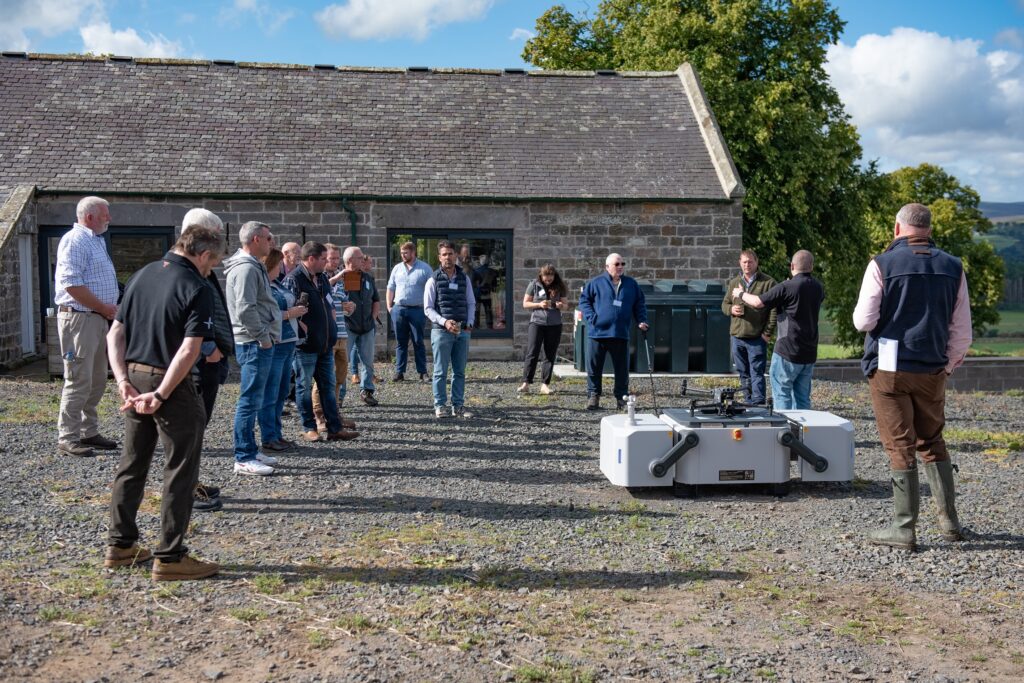
“Having the drone closer to the plot gives much more detail to the imagery. Photogrammetry is very good for detecting differences between plots, but it still requires ground-truthing by a person to analyse what the difference is attributed to. The Skippy Scout system does 95% of this.
“It should reduce much of the labour required to run trials and can help target where a researcher needs to check a trial by flagging specific plots that would benefit from checking,” adds Jack.
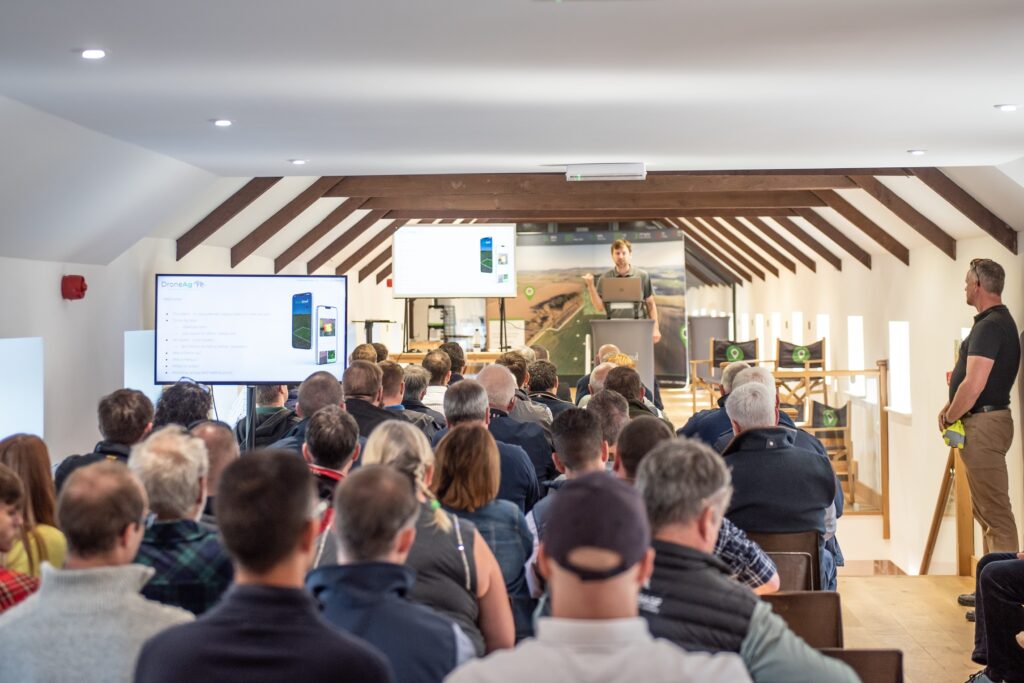
Fully automated flight on the horizon
The game-changing development for using drones in R & D will be if they become fully automated. This would enable drones to conduct many more assessments than has ever been possible, all carried out on a fixed schedule without needing a human to be present at the trial site.
“In a fungicide trial, we currently do disease assessments perhaps three times in the critical spring period,” says Jonathan. “If you really wanted to, you could fly every hour of every day to detect things we are currently missing.”
The technology is capable of unmanned and beyond visual line of sight (BVLOS) operations, but current UK regulation restricts its use. Agrii is working with heliguyTM, a leading drone retailer, consultancy and training provider, to help build the case for BVLOS use.
“At the minute, the regulation is pretty limited in the UK,” says Mark Blaney, head of training at leading drone retailer and training provider Heliguy. “Recently, the Civil Aviation Authority (CAA) has announced a ‘regulatory sandbox’. They have appealed for stakeholders to come forward to participate in a trial test of their proposed regulation to allow BVLOS.
“Companies will have to build up a use case with evidence of safe automated drone use to get authorisation from the CAA, which Agrii has been doing with their existing work.”
“Bringing together the skill sets in these three companies will lead to long-awaited innovation in field trials. Enhancing data collection methods beyond traditional photogrammetry techniques by using the advanced analytics of Skippy Scout and combining this with full autonomy will increase the value of the trials Agrii complete across the UK and reduce the monotonous field assessments that need to be completed by highly qualified researchers,” concludes Dr Mann.




-
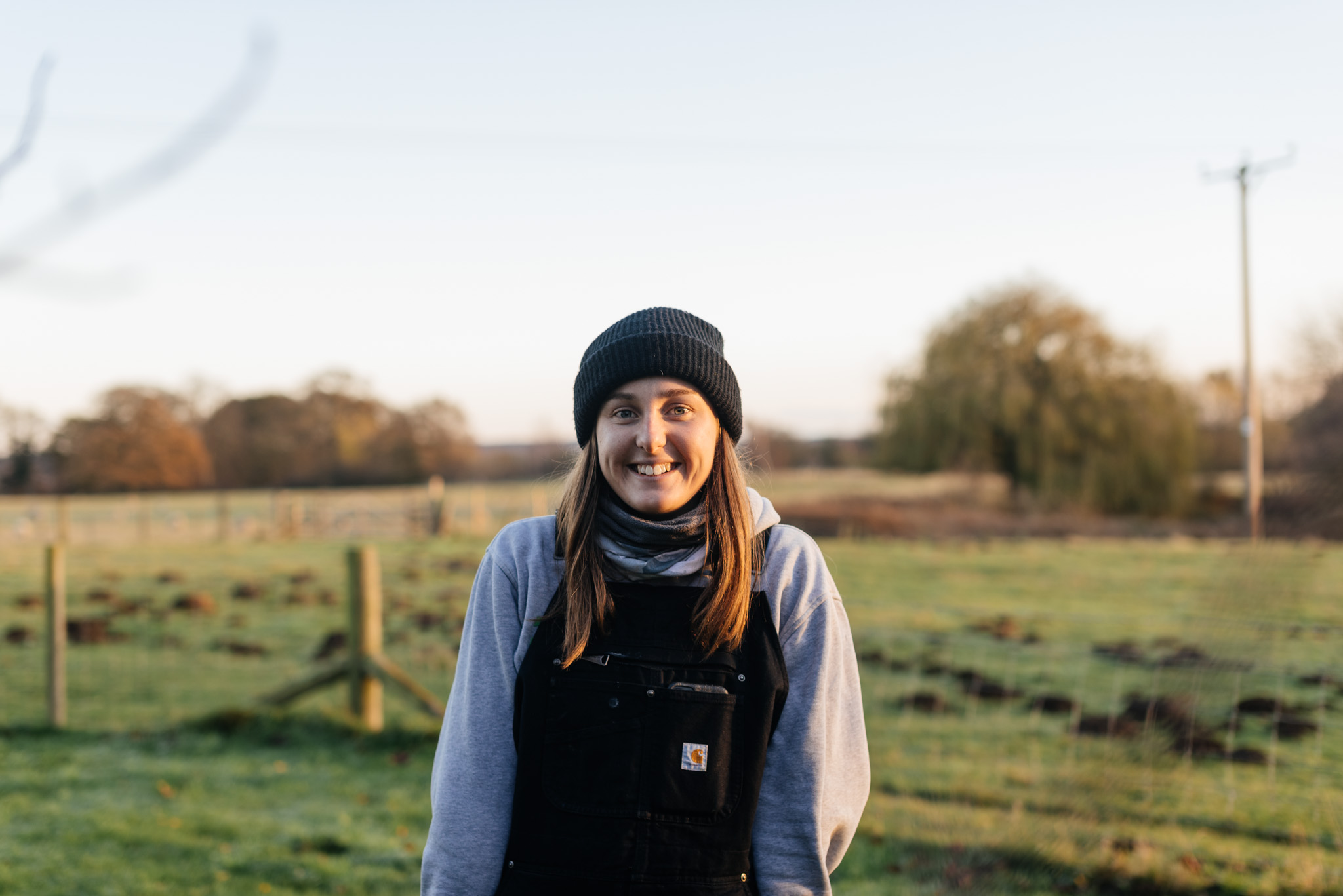
Farmer Focus – Anna Jackson
March 2024
February is supposed to be quiet?
For those that I haven’t met before, hello, my name is Anna and I’m 4 years into farming. I grew up on our family farm but made the move to return 4 years ago and haven’t looked back since. You may have met my Dad, Andrew Jackson, as he occasionally writes articles here too. DD asked me to write an article because I’ve got quite a few projects going on at the moment that are making my February bloody busy and reducing my hours sitting on the sofa with a cuppa.
First off we are coming up to lambing and for the first time ever we are going pasture fed only and lambing outside, a very terrifying prospect for me. We’ve always bought around £1000 worth of nuts to keep the sheep in good health ready for lambing. However, this year I have direct drilled 90 acres of grass which can happily keep my 74 sheep fed until lambing, if anything we have too much grass. After my sheep have come off this grass it will be used for outdoor pigs. This means I have to anxiously wait until the 15th of March to see how it all goes and in the meantime compared to last year where I was feeding them every day, this year all I have to do is top up their mineral bar once a month and check on them daily. I feel rather helpless but also a little smug as I’ve managed to reduce my workload.
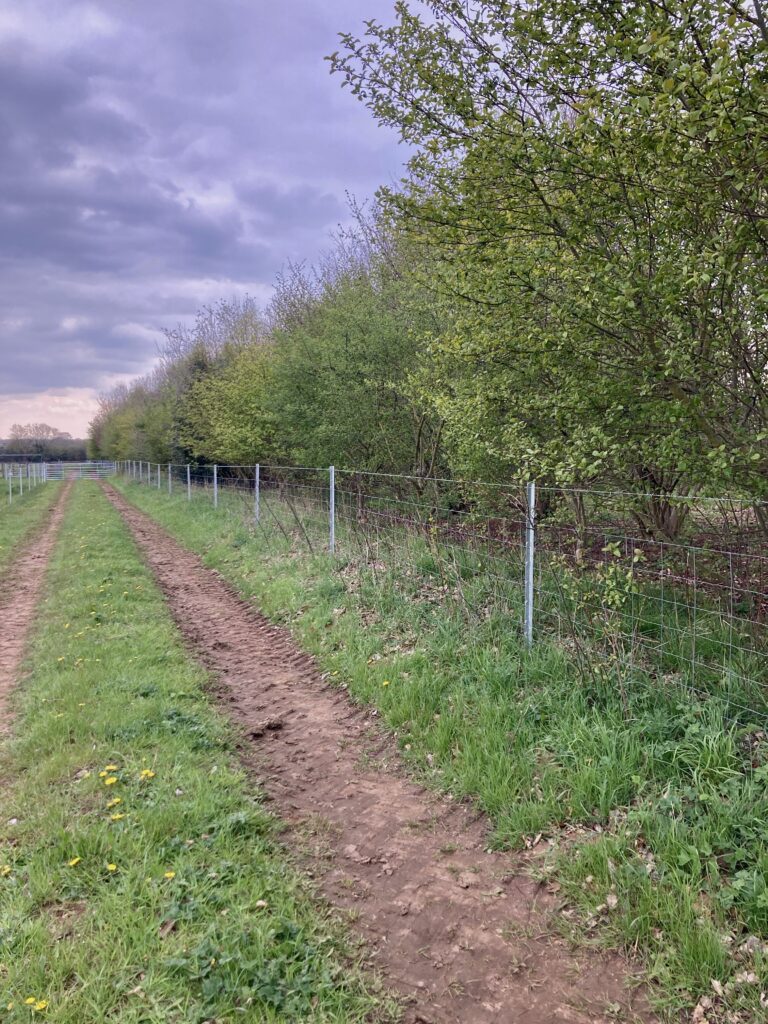
The next adventure is drilling our ‘boats’, beans and oats. This is all very new to me, I am the drill person on the farm. A job I absolutely love, we have a Horizon drill. However, I have never drilled boats before, a mixture of oats and beans. On the farm it is usually me who persuades Dad to try new ideas and sometimes I can work at him for a good 6 months until he says yes. I tend to go for a really crazy idea first then I’ll slowly make it more realistic. However after fighting for boats, I didn’t expect him to say yes straight away. So now I have to figure out the seed depth, which hoppers to use and fit that all around finding a weather window (near impossible with all of this rain we’ve had). Plus harvest. I’m really excited to see how we get on and I’ve promised Dad I’ll just do a trail field (or two). So watch this space we will either be harvesting very green beans or very green oats.
I’ve been working with the Future Food Movement to help put a face to farming. They basically start conversations happening between the supply chain and farmers. The idea is that they ask about our harvest and how it went, how much money we took/lost and basically how it’s going on our end. This isn’t a project that’s going to change the food system overnight but I’m hoping by chatting to them face to face we might start making steps to increase food prices and help them understand what is actually happening on the ground. So far I’ve also met some great farmers through this initiative such as Flavian Obiero (@thekenyanpigfarmer). I will keep chatting and keeping an open conversation, hoping for change.
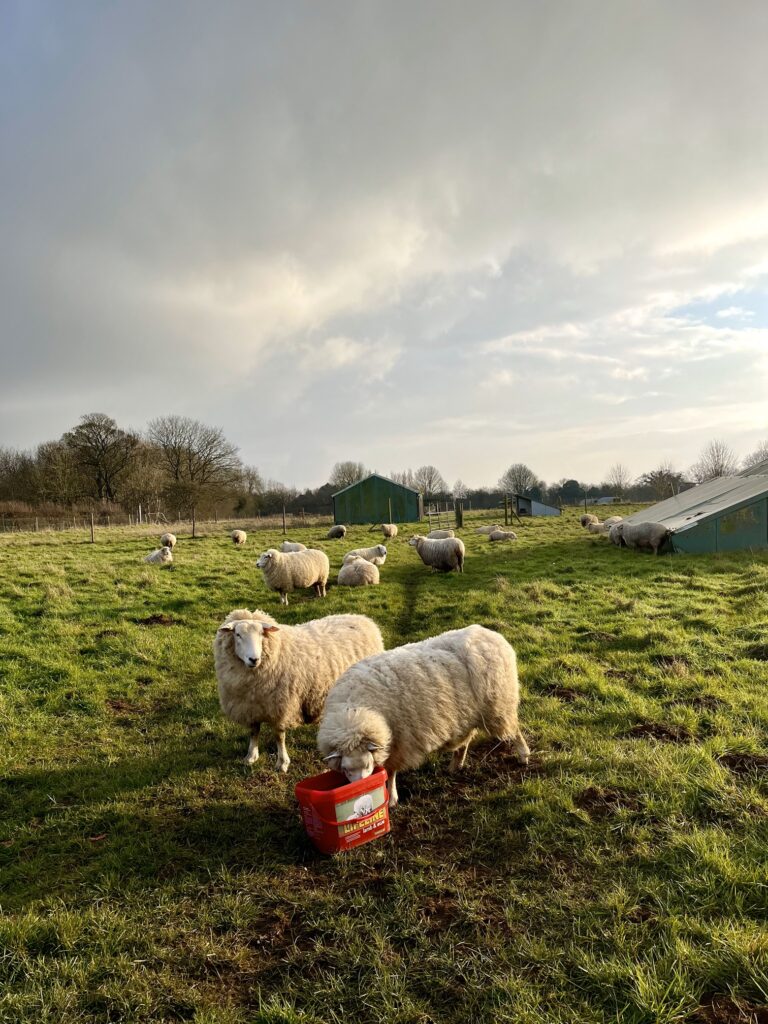
Volunteer crops have always interested me. The idea that a crop falls out of the back of the combine and grows in the most harshest of environments. It just kind of made sense to me to have a play with them so I am trailing volunteer Oil Seed Rape with 0 inputs because that way if the crop fails at least I haven’t put any money into it. We feel more confident going into this as we are being advised by RegenBen (Ben Taylor Davies). So far I’ve let the volunteers grow and grow they did! We have way too much coverage. Then I hard grazed it with sheep and they munched the crop right down to little stumps. Then the weather gods decided to partly flood the field which was lovely, luckily because we’ve been no till for 4 years or so it wasn’t too bad. And now it’s starting to grow again mainly with little off shoots on the munched down stems. But the most interesting part to me is that the roots are growing directly down however last year with the rape crop that we direct drilled the roots were horizontal and basically on the surface. I had a chat with Tim Parton about this and he said it’s because we put N on straight away last year and the rape roots are lazy so it wouldn’t have been bothered to root down. So much food for thought (pun intended). So currently we are still using no inputs, even though our agronomist is getting nervous, and we plan to just see what happens… hopefully finishing with a harvest.
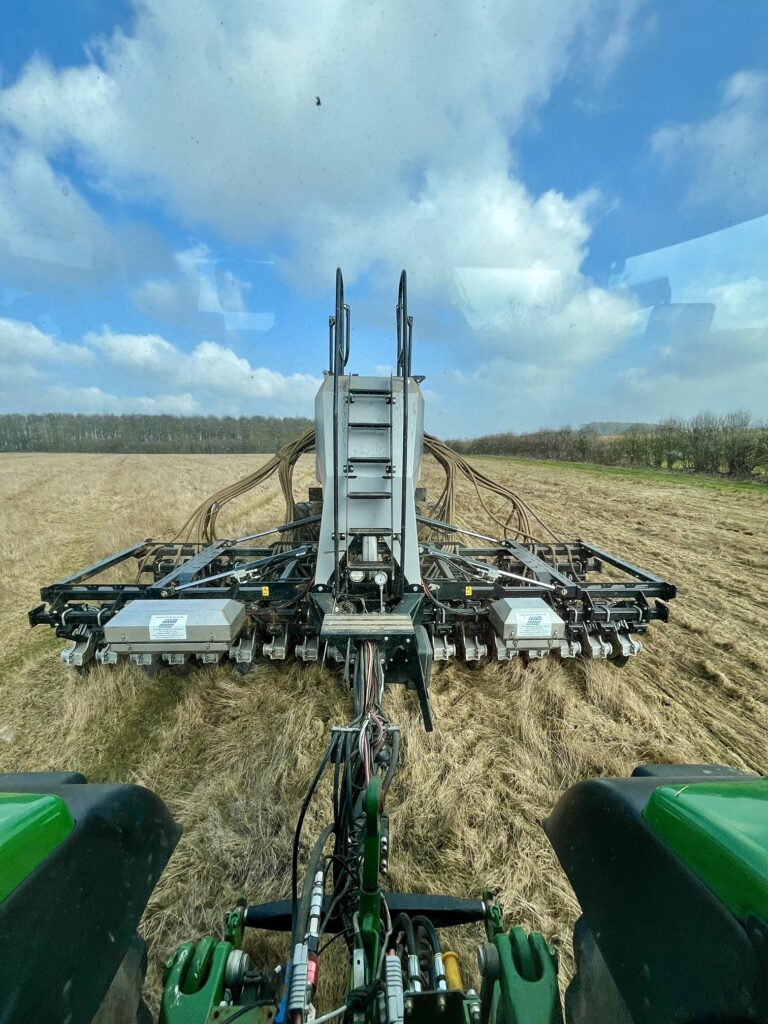
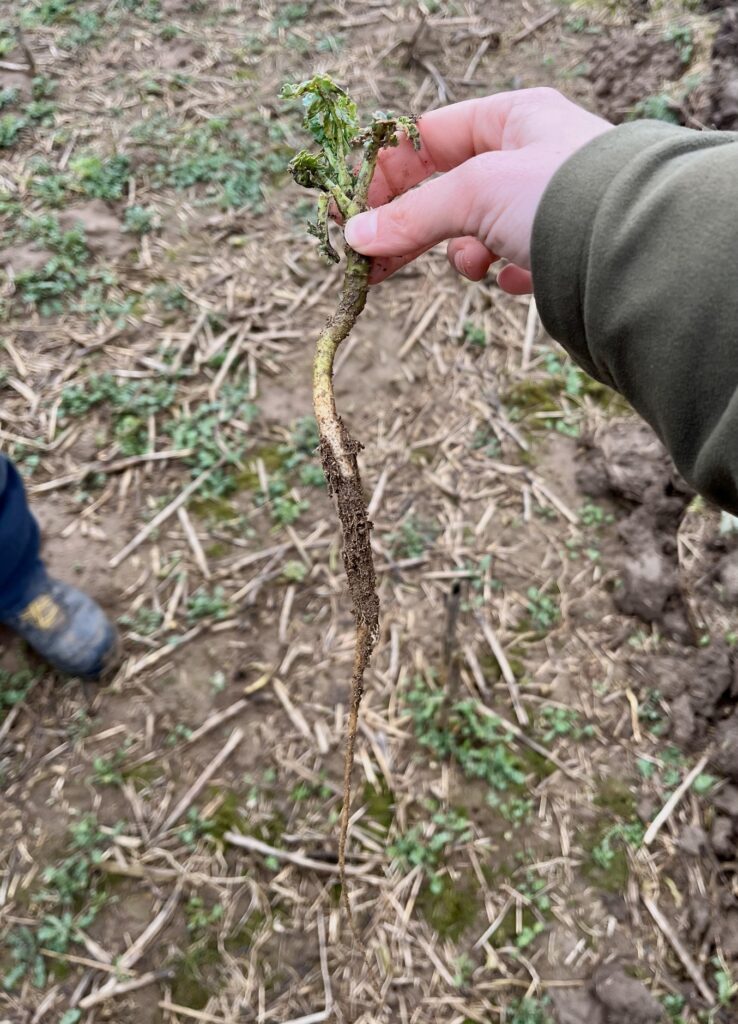
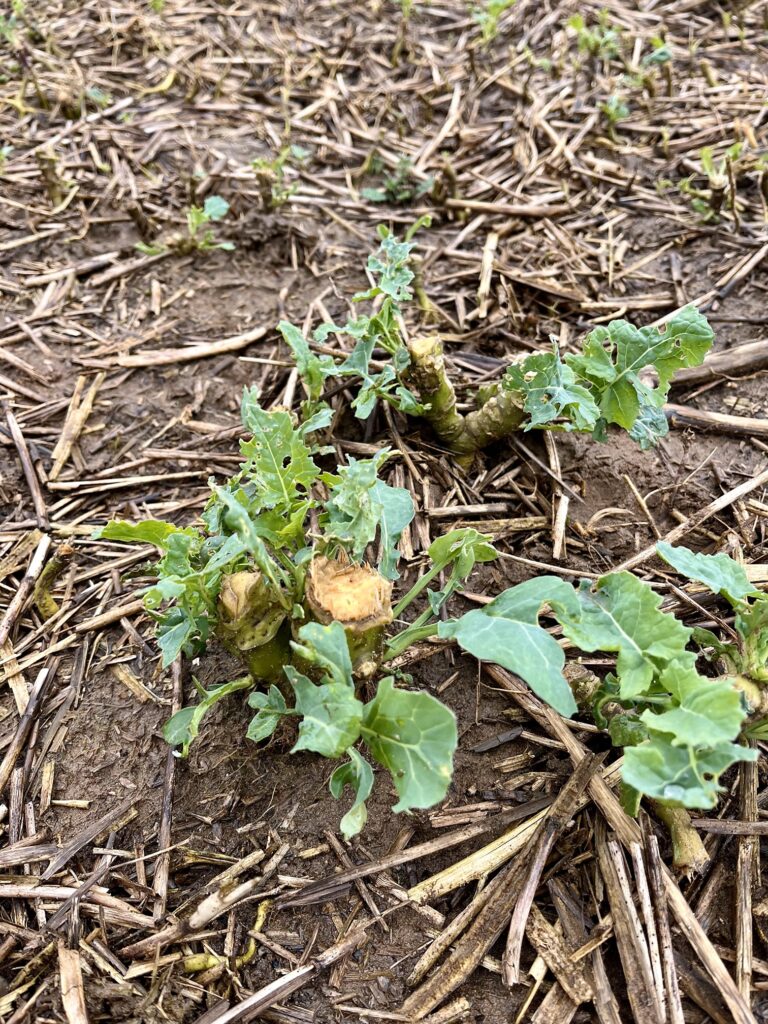


We’ve spent the winter putting up fencing around our farm so that we can graze it all with sheep eventually, the fences make it easier to move sheep on and off quickly. We managed one third of the farm this year with outside help. I thoroughly enjoyed the mini trailer we borrowed because I could wizz around on it so easily, it’s the little things. This year we’ve managed to graze our grass (for seed) which has a clover companion crop and the clover really needed munching down. We accidentally had sheep on the rape, some of them were very good escape arists, so we will see how that turns out. But our aim for next year is to put them on wheat and cover crops. I’ve been learning from Ed Horton (@e.a.horton) who has been putting sheep on his crop to reduce disease and has had some really promising outcomes. The final bit of fencing we need to finish this year is getting my sheep into some woodland because I believe ivy does wonders for sheep if they are in a bit of a pickle medically, this is a project I’m extremely excited about.


-
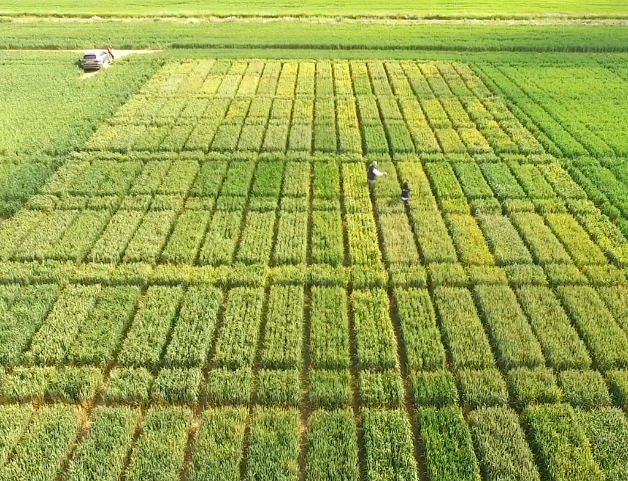
BYDV-Resistant Wheat
BYDV-resistant wheat is a relatively new concept in the UK that is creating significant interest among farmers and the seed trade.
Pressure from BYDV is building after the ban in 2019 of seed treatments that controlled the aphid vectors, while resistance to insecticide sprays is increasing and government policy on insecticide use is tightening.
Concern is not just confined to the traditional BYDV disease hotspots. Sub-clinical levels of the disease can also shave yields and erode returns.
Overall, annual yield losses in untreated crops average 8%, according to AHDB figures, but can reach 60%. And it is estimated that 82% of the UK’s wheat crop area is at risk from BYDV.
Clive Bailye is managing partner of TWB Farms, near Lichfield, a zero-till operation consisting of owned land, FBT and contract farming arrangements over several hundred hectares.
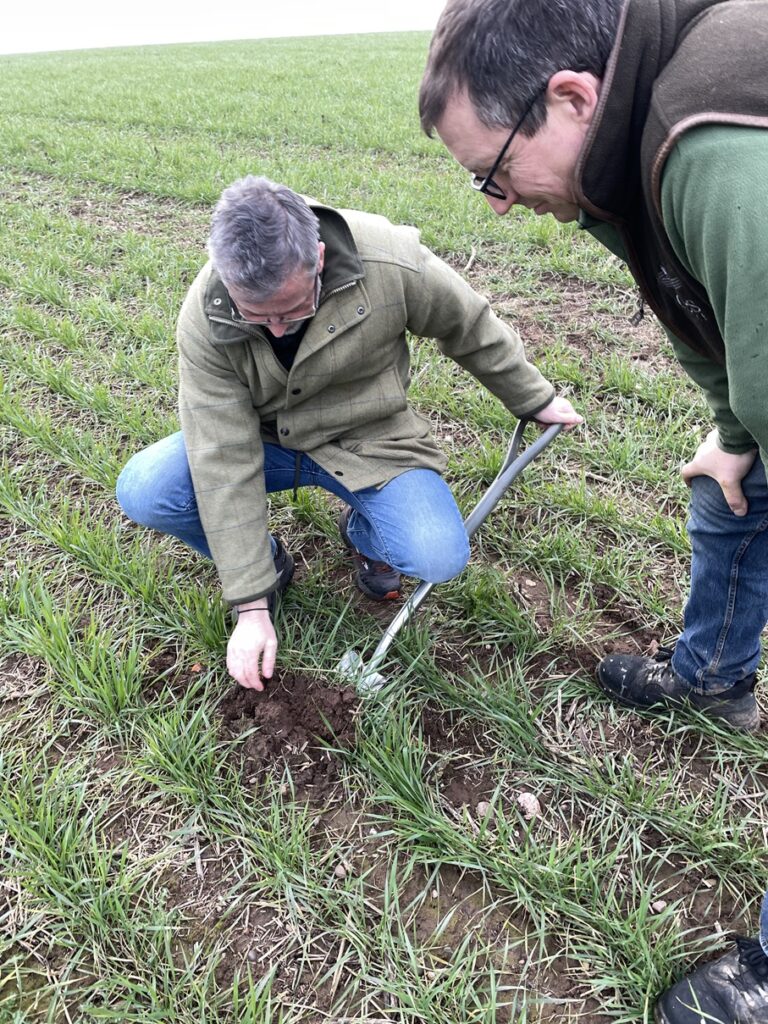
Clive Bailye and Martyn Allen from TWB Farms Whilst Staffordshire is not a high-pressure BYDV area, Clive suspects the farm’s wheat crops have been leaking yield.
“I haven’t sprayed insecticides for 16 years, but it would be very naive of me to say that we’ve never had BYDV since then,” says Clive. “We’ve not had any noticeable disease symptoms or yield loss, even in bad BYDV years, but in any given season sub-clinical levels of disease have probably been present in certain fields.
“That may well be costing me a couple of percent of yield, and that’s one reason why I’m keen to find out more about BYDV-resistant wheat varieties.
“The other reason is I want to maintain my no-insecticide policy at all costs. Whenever we use these synthetic products, or use unnatural techniques such as cultivation, we upset a balance. It might solve one problem but we could be creating another – there are consequences.
“Insecticides are more damaging to beneficials than most of us farmers realise. It becomes pretty obvious when you stop using them; on this farm, natural predators have increased in number to the point that they are doing the job for us.”
Clive believes the farm’s move to no-till, which began in earnest 16 years ago, is the reason why his no-insecticide policy has been so successful – visibly at least.
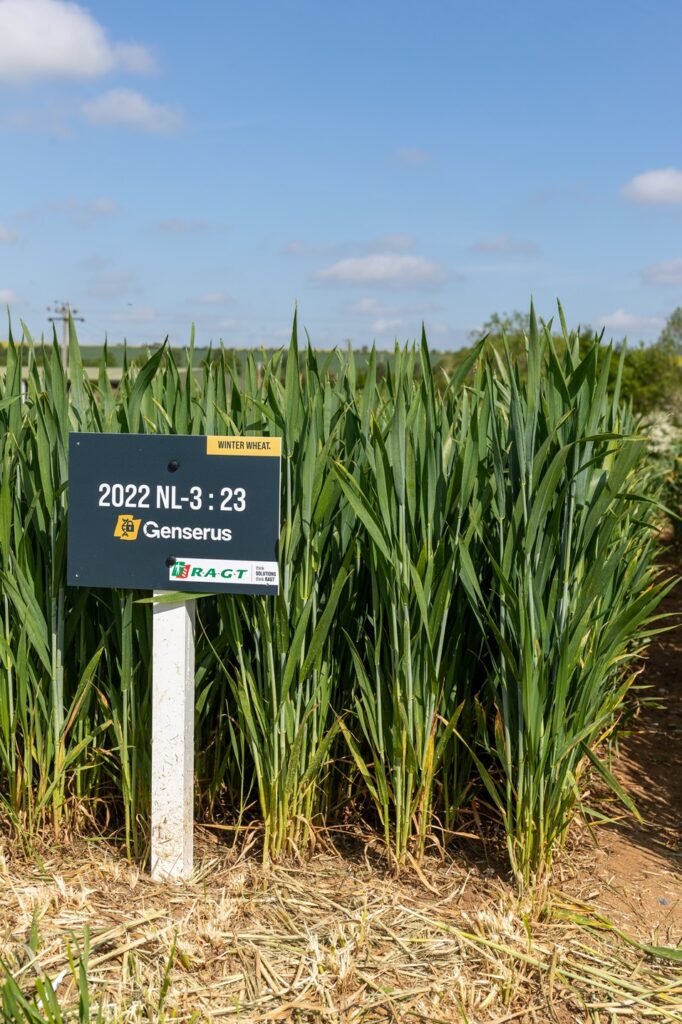
The move was initially a hard-nosed business decision, to reduce fixed costs and speed up operations as the farmed area expanded. However, it wasn’t long before Clive started noticing improvements in soil structure; fields were travelling better, creating wider operating windows, and plants benefited from the more friable soils.
“We stepped up our cover cropping, keeping soil covered with plants year-round, and introduced a more diverse rotation. We took the decision to improve soil and try to grow bigger yields whilst reducing dependence on synthetic inputs.
“But we never made a conscious decision to stop using insecticides. We had used them regularly in the past – it was cheap insurance. When we became more aware of the soil food web and how everything interacted, we decided not to use insecticides routinely, only if we had a problem.
“By the time we got to 2012, we realised that we hadn’t used an insecticide for over a year. We hadn’t had the need, and we still harvested decent yields. Was that luck? Rather than find out, we looked at what we could do to improve our chances of not having to reach for that insecticide can again.
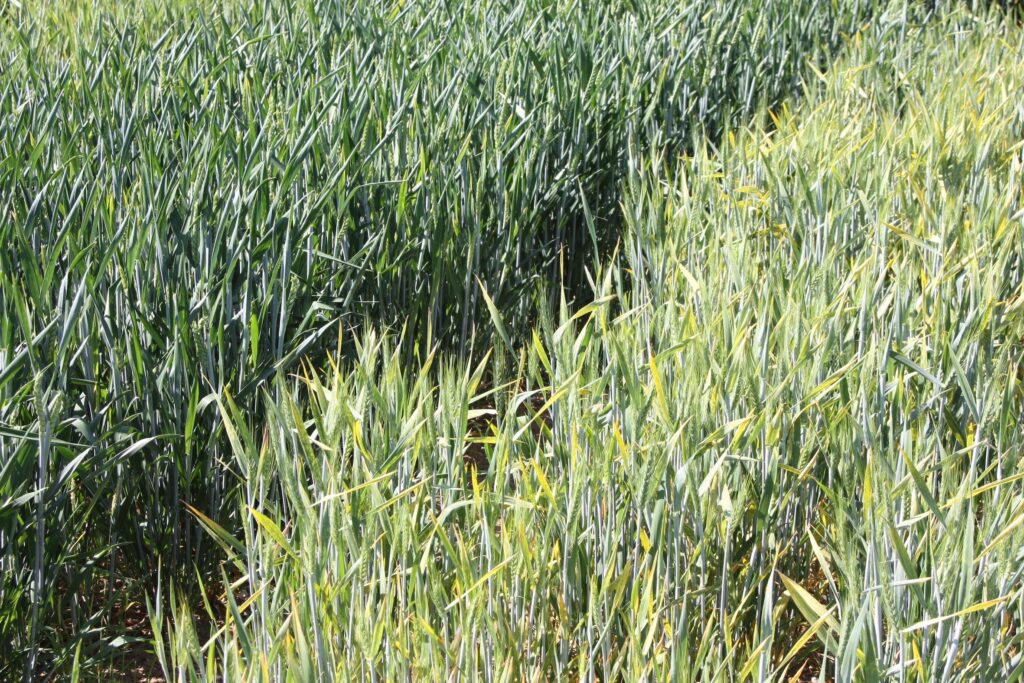
“We were creating this more natural environment where nature was more in balance. It’s not perfect, of course, but we weren’t getting those extremes of problems.”
Clive admits that being in a low-pressure BYDV area will have helped. Despite that, he is now seriously considering what BYDV resistant wheats can do for his business.
“I only grow wheats that are resistant to orange wheat blossom midge, and adopting BYDV-resistant varieties is the obvious next step. It is exciting technology that comes at very little cost, especially when you consider that we can now claim £45/ha on land managed without insecticides. Suddenly that insecticide doesn’t look so cheap any more – there’s a significant opportunity cost.
“We also know that pyrethroids used to control aphids are less effective than they used to be. And, when you look at the direction of agricultural policy, it’s obvious that pressure on their use will increase. It’s probably only a matter of time before we will rely on resistant varieties to control BYDV.”
Clive is growing 15ha of RGT Grouse this season as a “look-see”, a high-yielding Group 4-type wheat with BYDV resistance. He will assess its performance over the weighbridge, along with an adjacent field of Dawsum and a further one containing a four-way blend of feed wheats, none of which are resistant to the disease.
All will receive the same inputs. “This will give us some idea of the relative performance of the wheats on this farm in a no-insecticide system,” says Clive, who will use ADAS Agronomics tramline trial metrics to analyse the results.
“We’ll take out a 3ha block in the middle of each field, which should minimise any variation on what are fairly uniform fields. Of course, it might be that it happens to be a good Dawsum year or a good Grouse year, but it will still be valuable to see how these varieties respond.”
In addition, each 3ha block will also be tested for virus loading by RAGT, using quantitative PCR. “We may not be able to visually see any differences between the trials, but this will reveal whether we have subclinical disease, and how much, in the three different areas,” says Clive.
“This will be the most interesting part of the trial for me, as it will indicate the extent of our BYDV problem and the potential value of BYDV resistance to our business.
“The trait costs a few pounds per hectare, and it wouldn’t take much loss to cover that. And you get peace of mind, ease of management and all the environmental benefits, and an SFI payment as well.
“Eventually this technology will be available in many varieties, like orange wheat blossom midge resistance. That said, given the potential benefits, I don’t see any reason why I wouldn’t include a BYDV-resistant variety on my farm now.”
New trials network aims to reveal true impact of BYDV on wheat
RAGT has established a comprehensive set of insecticide-free trials across the southern half of England and Ireland to assess the true impact of barley yellow dwarf virus on a range of wheat varieties.
Jack Holgate, RAGT’s arable products manager, says the aim of the trials is to provide growers with much-needed information so they can make the right varietal choices to help manage the disease.

Jack Holgate, RAGT’s arable products manager “Official Recommended List trials don’t include this sort of assessment,” says Jack. “As a result, the effects of BYDV on the relative performance of wheat varieties are never considered. Varieties that are bred specifically to resist the disease never get a chance to show their true potential, so many growers are unaware of how the yield pecking order changes when the disease strikes.”
RAGT has set up an 18-trial matrix across the Midlands, south and west of England and in Ireland this season, using a range of popular commercial wheat varieties and some of the company’s current and pipeline BYDV-resistant Genserus (BYDV-resistant) varieties.
RAGT is working with several partners including seed merchants, Eurofins, AICC, agronomy companies and growers to establish the trials network.
“Some sites will be inoculated with BYDV-bearing aphids, others will be left to nature,” says Jack. “None will receive insecticide.
“We want to demonstrate what can happen under very high BYDV pressure and how Genserus varieties can cope with that, reducing costs and greatly easing autumn management. We also want to see what happens under a range of natural conditions. Growers can then decide for themselves whether Genserus technology should play a part in their risk management strategy.”
The trials will build on RAGT’s existing BYDV work, which reflect the resilience of the resistance trait, as seen in more than two decades of commercial production in Australia.
In BYDV-inoculated trials carried out at Ickleton, Cambridgeshire last season, seven Genserus varieties significantly outyielded their conventional counterparts. All plots received Recommended List-protocol fungicide and PGR treatments, but no aphicide.
RGT Grouse, RAGT’s main commercial Genserus variety, yielded over 8% more than Champion and almost 15% more than Skyscraper (see graph). Similar results were achieved in the two preceding years.

A trial carried out in County Cork by Goldcrop using natural BYDV infection also clearly demonstrated the strength of the trait (see graph).
“Genserus varieties took the top three places, with RGT Grouse equal top at 106% of controls,” says Jack.





-
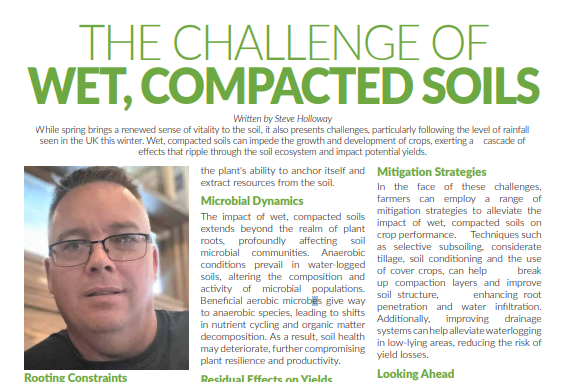
The Challenge of Wet, Compacted Soils
Written by Steve Holloway from Soil Fertility Services
While spring brings a renewed sense of vitality to the soil, it also presents challenges, particularly following the level of rainfall seen in the UK this winter. Wet, compacted soils can impede the growth and development of crops, exerting a cascade of effects that ripple through the soil ecosystem and impact potential yields.

Steve Holloway Rooting Constraints: Excess moisture and compaction create hostile conditions for plant roots, hindering their ability to penetrate the soil and access essential nutrients. In waterlogged soils, Oxygen levels plummet, leading to root suffocation and reduced nutrient uptake. Compaction further exacerbates this issue, restricting root elongation and lateral spread; limiting the plant’s ability to anchor itself and extract resources from the soil.
Microbial Dynamics: The impact of wet, compacted soils extends beyond the realm of plant roots, profoundly affecting soil microbial communities. Anaerobic conditions prevail in water-logged soils, altering the composition and activity of microbial populations. Beneficial aerobic microbes give way to anaerobic species, leading to shifts in nutrient cycling and organic matter decomposition. As a result, soil health may deteriorate, further compromising plant resilience and productivity.
Residual Effects on Yields: The consequences of wet, compacted soils can linger long after the rains have subsided. Crop yields may suffer due to stunted root growth, nutrient deficiencies and increased susceptibility to pests and diseases. Compaction scars the soil, leaving behind physical barriers that impede root penetration and water infiltration, perpetuating the cycle of poor soil structure and reduced productivity.
Mitigation Strategies: In the face of these challenges, farmers can employ a range of mitigation strategies to alleviate the impact of wet, compacted soils on crop performance. Techniques such as selective subsoiling, considerate tillage, soil conditioning and the use of cover crops, can help break up compaction layers and improve soil structure, enhancing root penetration and water infiltration. Additionally, improving drainage systems can help alleviate waterlogging in low-lying areas, reducing the risk of yield losses.
Looking Ahead: As we navigate the complexities of springtime soil management, it is essential to recognise the interconnectedness of soil, crops, and microbial life. By adopting holistic approaches that prioritise soil health and resilience, farmers can mitigate the impact of wet, compacted soils on crop yields while fostering sustainable agricultural systems that endure for generations to come.
Soil Matters! Corrective measures
Using metals, can be counter intuitive.
Biology – NOT metal makes tilth. Optimising it’s living conditions with bio-positive actions will promote structured aggregation; meaning that water ponds less, plant rooting is better and plant health improves.
Overtime, the weight of sitting water exacerbates compaction issues, creating cold, anaerobic conditions; bereft of life and sometimes corrective measures using metal can be counter-productive.
Collectively, the use of machinery at the wrong time and pulling metal through the ground, adds to compaction issues, destroying natural soil structures, decimating the homes of the living organisms. A soil can be naturally resilient but practices such as minimising tillage, building organic matter and promoting biological activity MUST be foremost in a growers mind.
DAMAGE CAN TAKE SECONDS BUT LAST FOR YEARS!


-
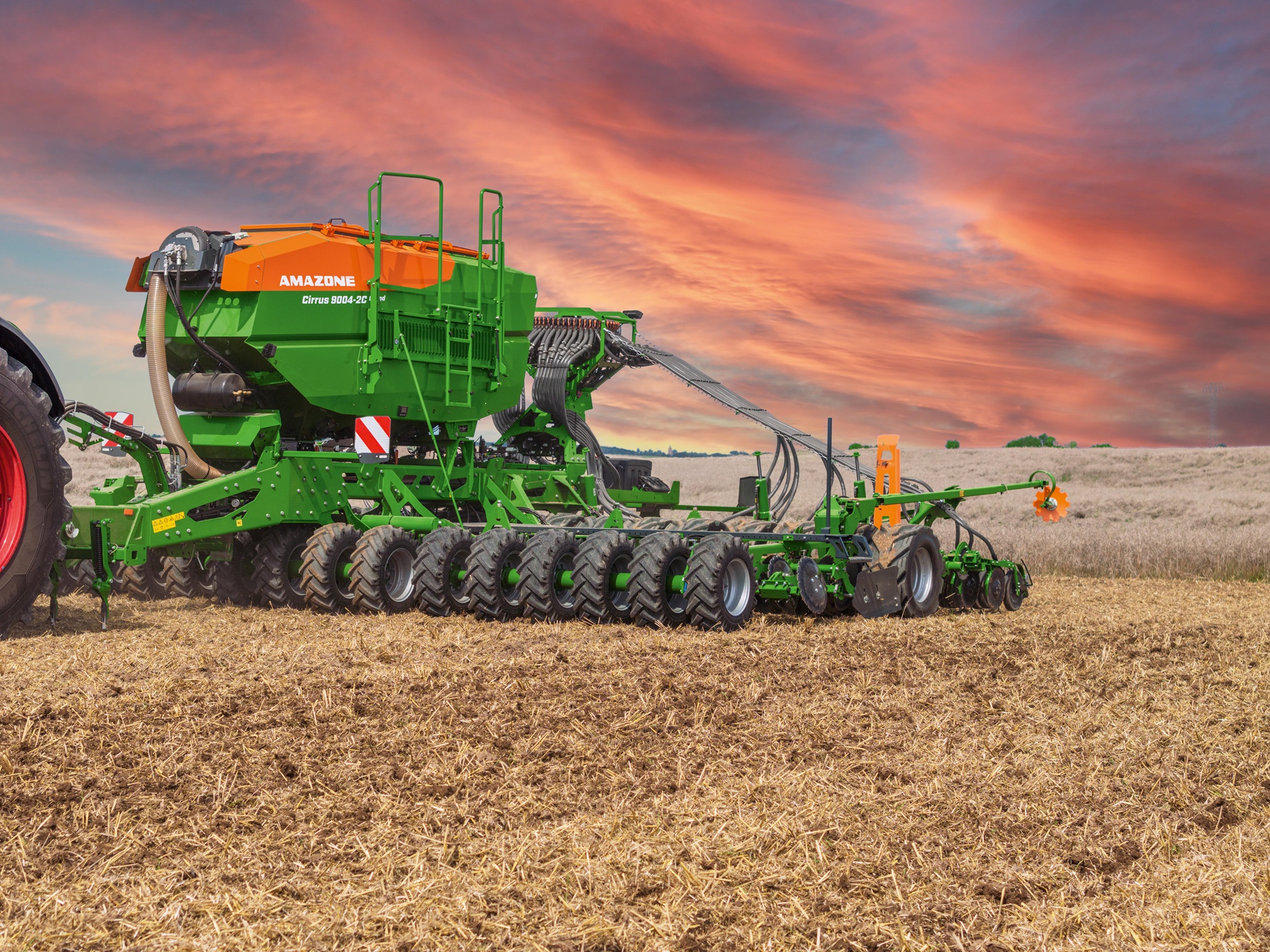
Tech defines how inputs are applied
With Amazone notching up 140 years of machinery manufacturing last year, Direct Driller takes a look at how its technology has developed.
Over one million fertiliser spreaders have been built by Amazone, and 2024 is the 75th anniversary seed drill production for the company. Based in Osnabrück, Germany and manufacturing at eight sites across the world, Amazone is owned by the Dreyer family and is now looked after by the fourth generation. The company has a long history in both crop establishment and crop care equipment and seeks to establish itself as the ‘harvest to harvest specialist’.
Dr. Heinz Dreyer brought the first PTO-driven twin disc mounted spreader, the ZA, onto the market in 1958 putting Amazone firmly on the map in the world of spreaders. Nowadays, the flagship TS spreading system, in either a mounted 5000-litre or trailed 10,000-litre hopper format, offers up to 54m spreading widths and 128 section shut-off. The technology on board includes the TS border spreading system, ArgusTwin radar spread pattern monitoring and automatic adjustment of any wind influence through WindControl. Such advances were not even dreamed of back when the first ZA was put in the field.
As well as drills and fertiliser spreaders, there’s been over 50 years of sprayer production. The S400 mounted sprayer started in 1969 with a 400-litre spray tank and 6m boom and now encompasses mounted sprayers up to 3500 litres, trailed up to 11,200 litres and the Pantera self-propelled including the all-new, self-levelling, 7000-litre Pantera 7004.
The last 75 years has seen huge changes in crop establishment methods. The D1 seed drill was introduced just after the second world war and was soon joined up to a cultivator with the development of the RE reciprocating harrow making the first drill combination. The following 75 years has seen both the level of technology and the breadth of the range multiply exponentially.
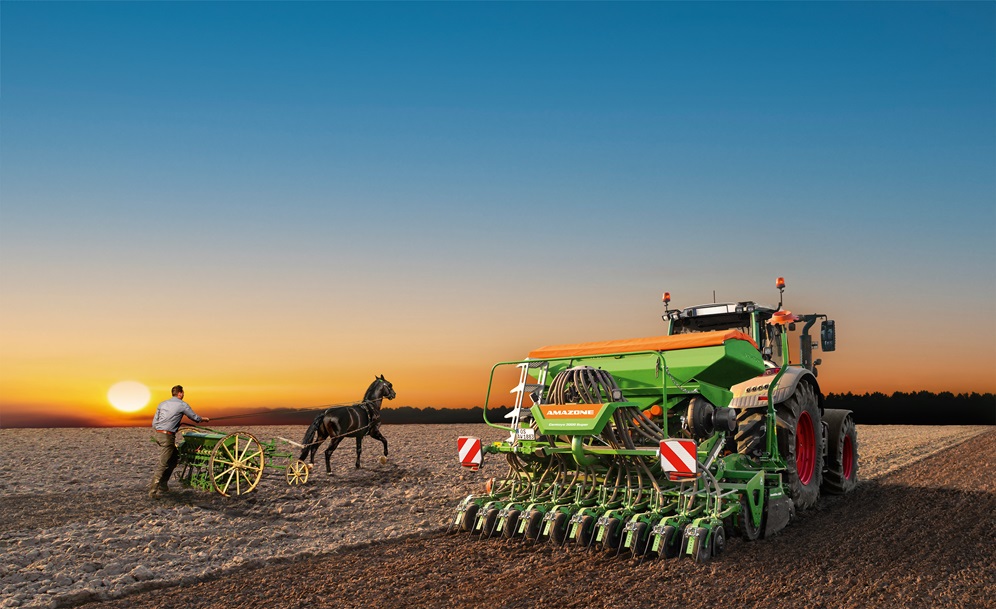
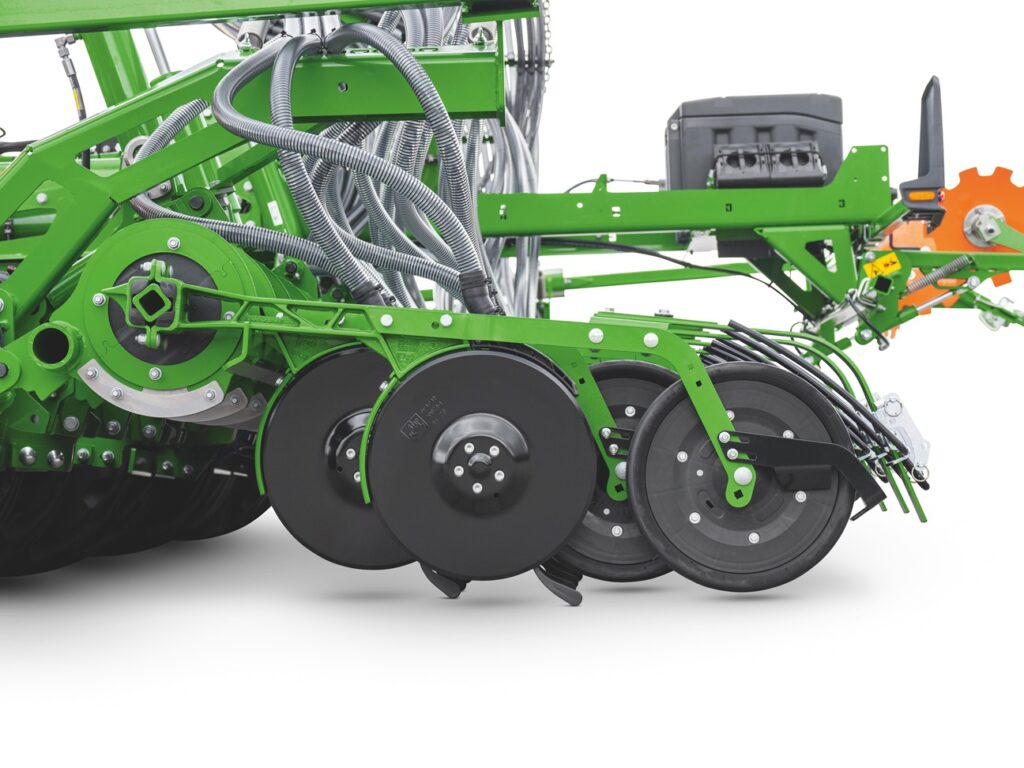

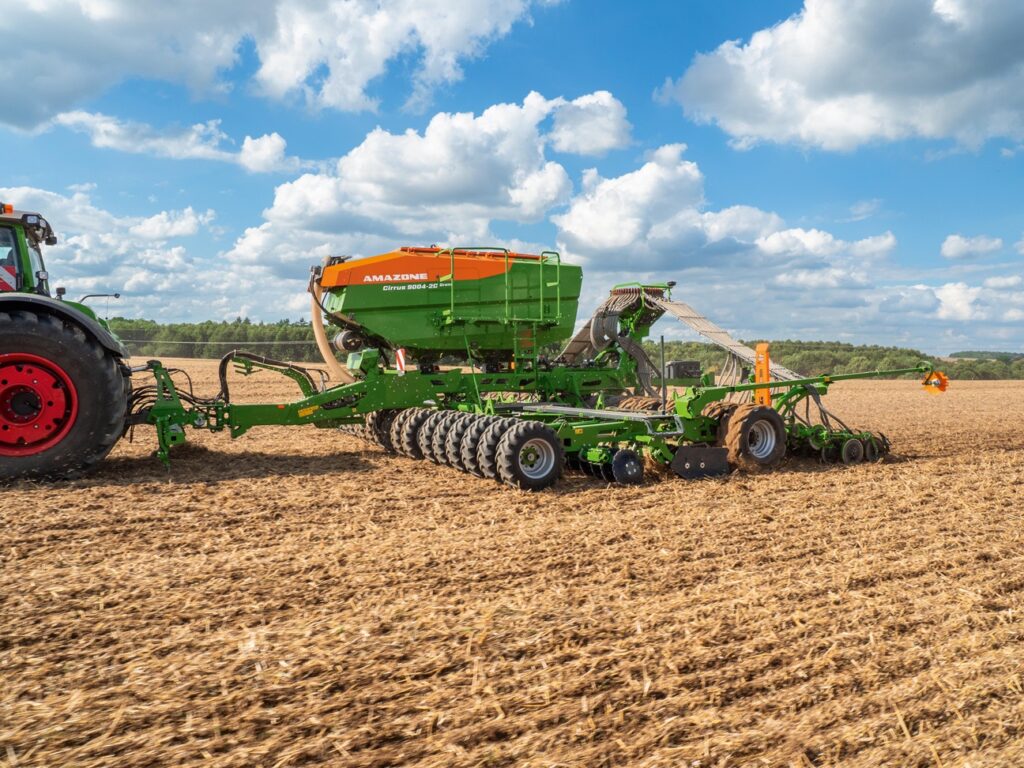

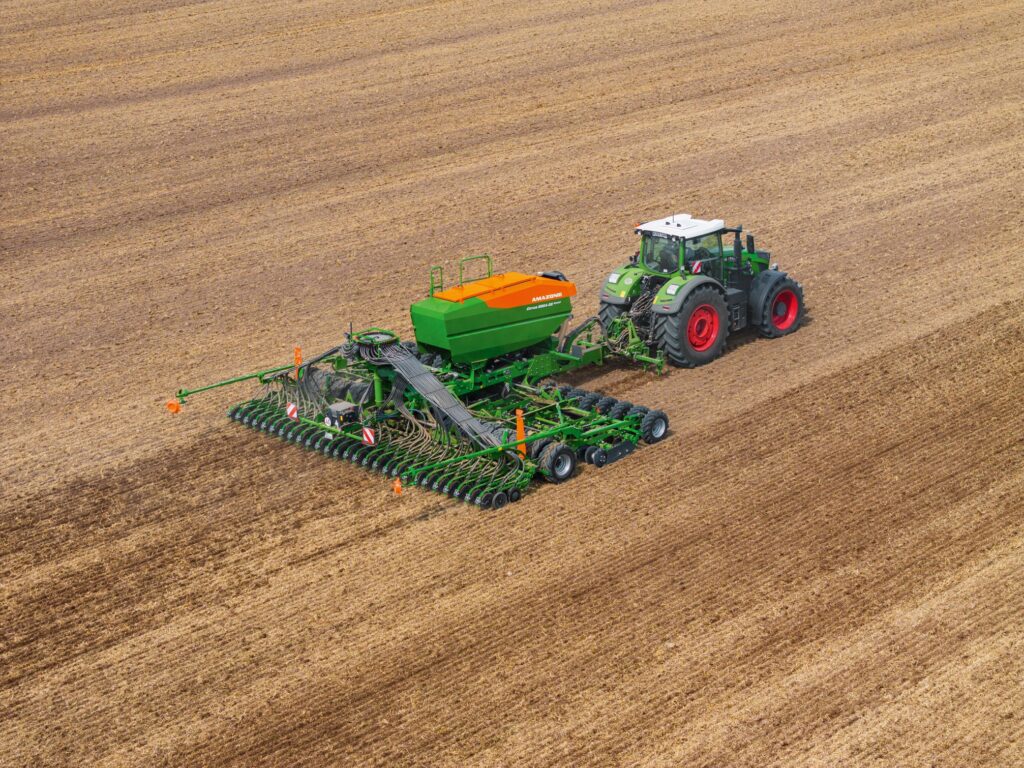
Those linkage- and harrow-mounted drills and drill combinations still form a significant part of the thousands of drills produced each year. But changing establishment methods have seen a diversification into trailed tine seeders, direct-tine seeders and solo trailed disc drills along with the multi-purpose Cirrus drills. The need to sow multiple seed varieties at different rates, and also at different planting depths, has led to drills with multiple hoppers and coulter systems. This can also be used to sow a mixture of seed and fertiliser either alongside the seed as a SingleShoot system, or at a different depth using the FerTeC coulters in a DoubleShoot set-up. An additional GreenDrill seeder box can be added for a third material including the application of micro-granular herbicides and slug pellets.
The renewed emphasis on direct and low-disturbance drilling has seen an increasing demand for tined drills that can direct drill into surface residues and cover crops and yet, as opposed to disc drills, still generate a clean seed slot to ensure good seed/soil content. The Primera DMC offers the flexibility of being able to be used conventionally, in a min-till scenario or as a direct seeder. The relatively close row spacing of 18.75cm, set in a four-row opener lay-out, offers generous point-to-point clearance and allows the Primera to handle drilling in trashy conditions. And the same can be said of the 12m and 15m Condor seeders. The 7800-litre seed hopper is split into three sections to give maximum flexibility and the ConTeC pro openers in three stagger and a 25cm row spacing again give good throughput.
Fast forward to 2024 and one of the latest additions is the new Cirrus 9004 Grand trailed cultivator drill. Designed for high output, the Cirrus Grand comes in a 9m working width and with a split 5750-litre seed hopper that can supply both seed only or seed and fertiliser to the TwinTeC+ double disc coulters. The seed is distributed to the coulter via the new seed-on-demand, individual row shut off head.
Any tramline width or wheel track width can be set from the terminal. When a row is isolated, for tramlining or on headland ins and outs, the seed is kept circulating within the head until needed, this gives instant response to any situation leading to minimal misses and overlaps. The air flow to the coulter is always there and remains constant across the full drill width to avoid blowing the seed out of the seed row as more rows are isolated. The V-Compensation system means that on the way out of the headland, the longer pipe runs are started first to ensure even seed delivery across the whole working width or, on entering the headland, the longer pipe runs stop first giving a uniform emergence over the whole field.
Whatever the model of drill chosen, keeping that flexibility of drilling open is key to being able to cope with any upcoming political and environmental pressures that farming may face in the future.


-
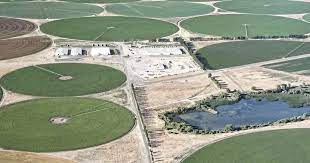
Achieving the potato impossible
Written by Harry Barnett
I never dreamt that a soil disturbing potato farmer like myself would be writing an article for the Direct Driller magazine but I feel privileged to share some of my findings and views. I am based on the Holkham Estate in North Norfolk, where I run a potato growing enterprise growing salad, maincrop, processing and seed varieties. I am a millennial and a realist. On one hand, my millennial moral compass pushes me to make environmental and social improvement, whilst my realist values tell me that we must avoid risk and remain commercially competitive and profitable in business.
In 2023 I was fortunate enough to be awarded a Nuffield scholarship, kindly sponsored by McDonald’s UK & Ireland and the Royal Norfolk Agricultural Association. I am researching how UK potato farmers can counteract the market and agronomic challenges they currently face. I have seen the great, the good and the downright ugly side of potato farming across the globe.
At the start of my journey, when pondering my title, the prospects of the UK potato sector looked bleak, with a steadily declining retail market, incredibly low margins and poor return on capital. Combine this with an unpredictable climate, pest and disease pressures, and as a result a UK grower exodus is underway. Across the globe some of these common themes exist, with countries and continents having their own solutions to overcome them.
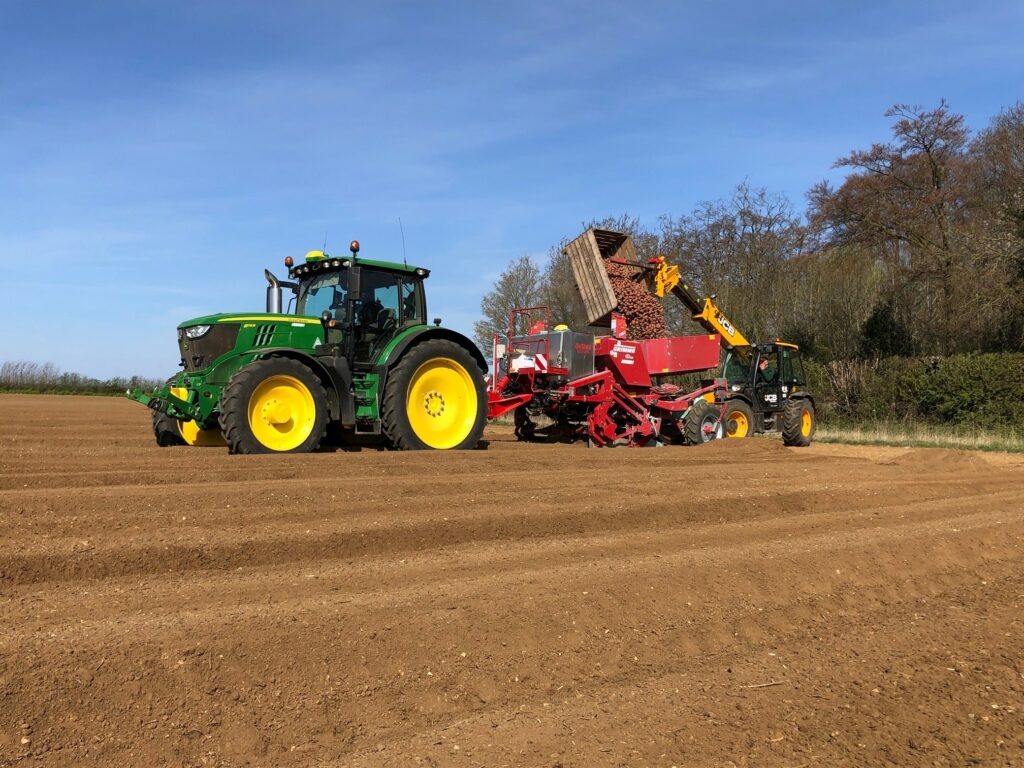
Perspectives from abroad
Our European neighbours are the most aligned with their growing challenges, most notably with a scarcity of water during the growing season and an abundance during harvest – a familiar tale. They also face a political landscape which appears to be more authoritarian and restrictive than the UK. I visited farms in the Netherlands, who are battling the government on greening rules that restrict phosphate and nitrogen use, and French farmers who are having water use restrictions imposed on an annual basis. These challenges are making it harder to deliver marketable yields consistently.
North America is on a completely different path to our European counterparts. Washington state in the USA produces some of the highest potato yields in the world. Their farmers make the most of long growing seasons, deep silty soils and the Columbia River. They tailor fertiliser and agronomy programmes to enhance yields and keep pests and diseases at bay.
Honestly, I was frightened by the input use and struggle to see how this is going to be maintained in a long-term sustainable farming strategy. Fumigating soils with 40 gallons an acre of an organophosphate whilst applying 30 inches of water to a crop annually cannot be good for the long-term health of the public and environment. This is certainly not something that can be mirrored in the UK.
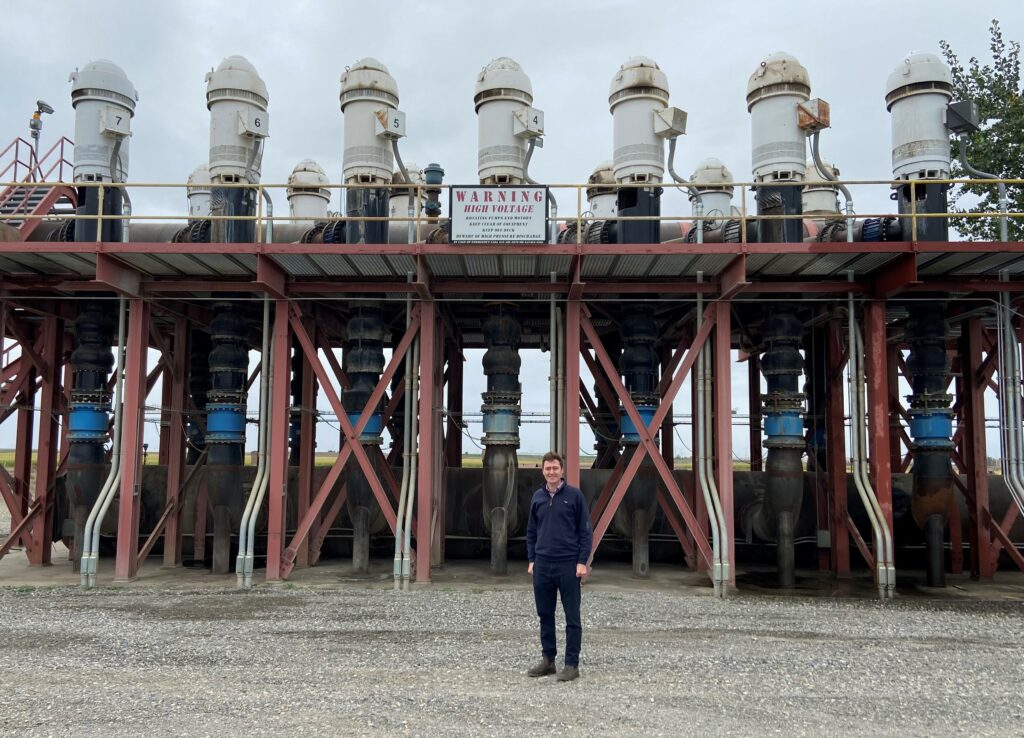
An irrigation plant in Washington Reflections
One thing that Nuffield has taught me is not to be judgemental. US farmers are asked to produce plentiful, cheap food, and their potato growers succeed at a scale and efficiency level that European farmers cannot begin to imagine. The US model of scale and inputs reduces risk, therefore allowing farmers to be successful at margins that would bankrupt UK producers.
In my opinion, change is required away from conventional high input systems as part of a long term sustainable food strategy, however, removing inputs reduces control and adds risk. If the UK and European consumer want nutritious, environmentally friendly produced food, they will have to pay more for it in the short term, either through increased prices on retail shelves or more indirectly through increased government support.
Making changes at home
This planting season, our business is striving to achieve what many around the world would perceive to be the potato-growing impossible. We will set out to grow a salad potato crop with no artificial fertiliser, no synthetic fungicides and no insecticides whilst achieving the same marketable yield as our conventional salad crops. Impossible? Five years ago, I would have said yes and told you it is commercial suicide.
The risks involved in the wrong growing season would see our business lose a six-figure number across a 10-hectare field if, and when, it goes horribly wrong. We will achieve this by:
- Growing a Dutch-bred salad variety with strong agronomic traits and very high blight resistance
- Applying a fertiliser that uses clever technology to recycle waste streams with a carbon footprint 80% lower than conventional fertilisers
- Using a keen eye from the agronomist (me) making sure that the crop remains healthy.
For context, on a conventional salad potato crop we would usually apply 8 prophylactic fungicides to keep blight away, a soil borne fungicide to control soil pathogens such as rhizoctonia and black dot and an artificial blend of fertiliser containing DAP, AN and MOP.
I am fully aware that this is a small step and only represents a tiny fraction of our growing area, but it is progress.


default 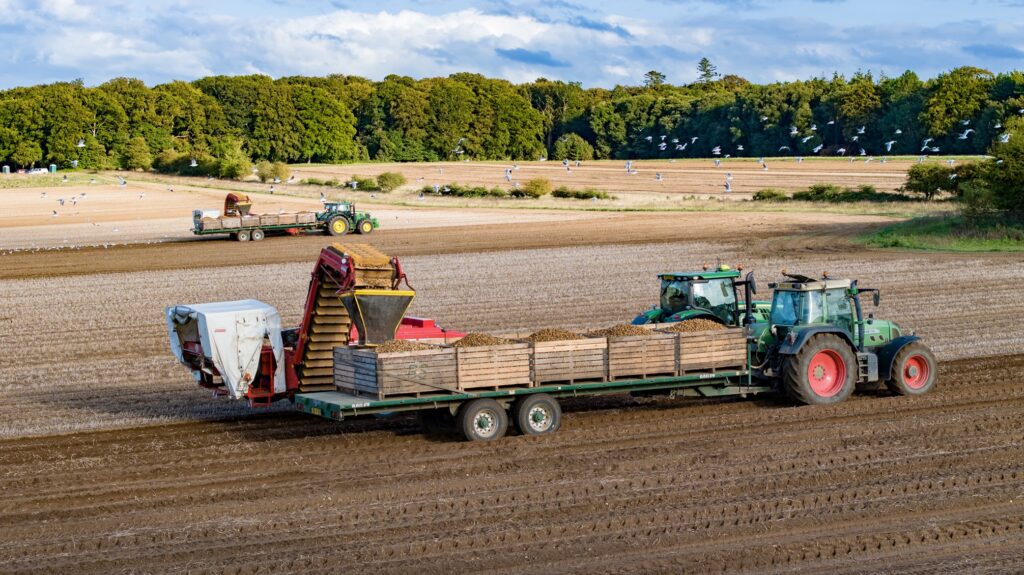
default 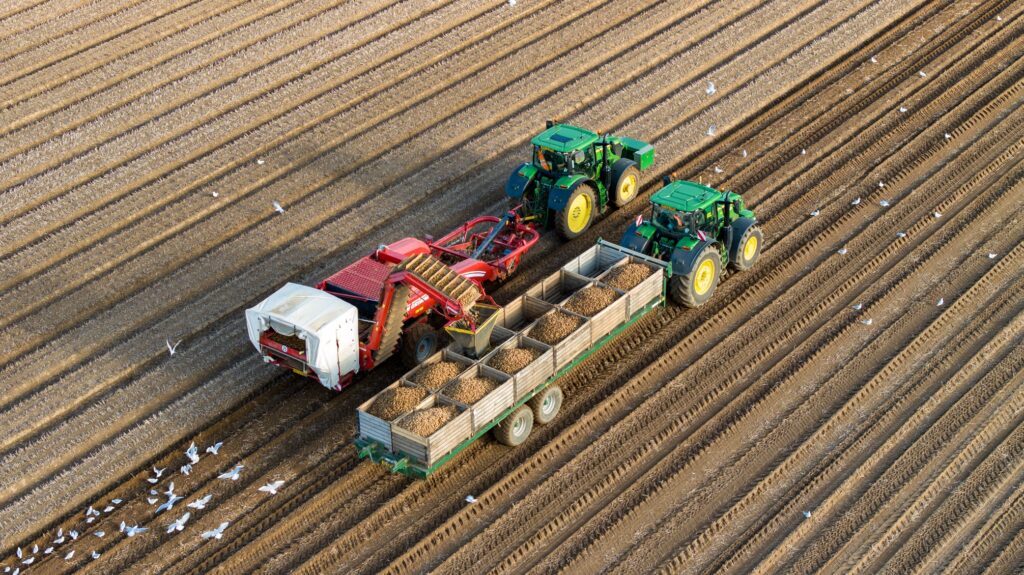
default Better tools
There is a famous saying that a bad workman blames their tools, and there is definitely truth in this. However, farmers do need realistic tools to move in a sustainable, dare I say, regenerative direction. The tools slowly begin to emerge, and it is important to remember that these things take time – as a farmer you get one chance per year.
I have visited potato breeding companies on my travels who were quick to point out that up until five years ago, breeding programmes were completely focused on yield rather than resistance. Adding stronger agronomic traits that reduce the use of inputs is very new, and I came away excited as to what can be achieved, even with conventional breeding techniques. Strong plant genetics that can fight off pathogens are going to be essential for farmers to hit input reduction targets.
I come back to my opening gambit of being a millennial and a realist. Through my working life, I truly hope and believe that the move away from the artificial inputs that have propped up the world’s food system is a real possibility rather than just a hippy pipe dream.
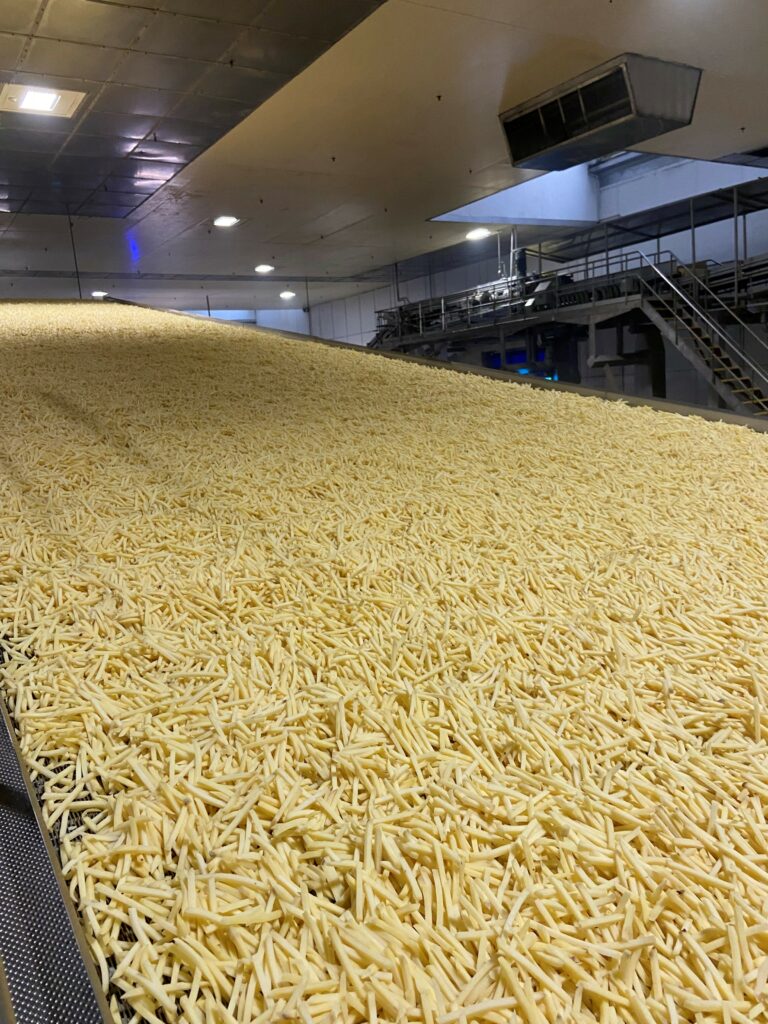
French fries matogues One thing that has given me hope for the UK potato sector is the fact that demand for potato products is increasing across the globe. The ‘french fry’ and the ‘potato chip’ (crisp) are cemented in western diets and the growth around the world is huge as people trade into these products. Whether I should be commending this is for another day, but I truly believe the humble potato, a staple in UK diets for centuries, should be championed and embraced in our UK farming systems. After all, the potato in its unprocessed form is the most carbon efficient and the most nutritious carbohydrate on offer to consumers.


-

Farmer Focus – Phil Rowbottom
March 2024
It feels like a very long time since my last ramblings in the October issue of Direct Driller magazine. I’m sure I’m not the only one that thought we’d never experience another winter like we had in 2019, the wettest on record at the time!
While winter 2023/24 may not have seen the surface water running through the yard we experienced in 2019, there are places on the farm that I’ve not seen water standing in all the years we’ve been here, we recorded the highest rainfall here at Mount Farm Woolley, a staggering 900mm for the year, almost double on the year before.

I felt quite fortunate back in October to have managed to get everything planted before the weather got really bad, the crops don’t look quite as good now as they did back then! Oilseed rape has for sometime been the biggest gamble on the farm, after a couple of good years, it’s seems Cabbage Stem Flee Beetle has found its way back to this part of Yorkshire, having twice drilled one field late last year, a combination CSFB, pigeons and the weather, after consultation with my agronomist, we decided the best course of action was to plant winter wheat into it, add into that the sheer costs and risk involved and the options with SFI, OSR’s days may well be numbered here!
Miraculously, a weather window opened presented itself at the end of January, on the 2nd of February I was back out with the Sky Drill planting Skyscraper winter wheat, at 240kg to the ha, into what can only be described as almost perfect conditions.
Dry, sunny, a light breeze, if it hadn’t been for the temperature you could have been lulled into thinking it was Spring! Having seen the amount of water lying on neighbouring land, it was surprising just how well ground travelled.

As I write this its still raining, the forecast is for more rain, having managed to get 110kg per/ha of nitrogen applied, I’m estimating there is around 10% of the farm that won’t produce a crop due to the weather, the biggest piece, around 15 acres has pretty much failed completely 3
years after potatoes will have a mix of wild flower, Facilia and buckwheat cover crop planted in it and left until the autumn.
With input costs continuing to be high and wheat prices as they are, costs will be focused on year more than they have ever been, if we can reduce inputs and not effect yields then we will push the limits as far as we can. Having not sold anything out of the shed to date, like so many, we’re waiting for the prices to creep up!
Now into the third year of Direct Drilling, the benefits are becoming more and more plain to see. Admittedly we farm some pretty easy, free draining light sandy land, the benefit of not disturbing the soil structure, pays dividends in being able to access the ground sooner than the old plough based system.
By not disturbing the soil, leaving tramlines in the same place, keeping trailers on the headlands, chopping straw to add to organic matter all seem to help here. planting cover crops between harvest and the next crop all help with soil health. It just seems to work here.
(Pic 4)
I’m sure many of my neighbours think I’m mad, but all I can say is come and have a look, the proof is there for everyone to see. We recently hosted a farm visit form West Yorkshire Combined Authorities, a mixture of academics and farmers to see what we are doing and how it can play a role in their future environmental policy, a very informative day listening to other farmers talk about how they can see the benefits and challenges on their farms and to share the wider environmental and ecological improvements we are seeing with a none farming audience, just a pity the weather did’nt play ball, but that’s farming!


-

Crop nutrition after the storm…
As the daylength increases we are all now waking up from what feels like the mildest ‘winter’ and longest wet spell ever experienced (since the last one anyhow!). It feels like it started raining in July and we haven’t really had a respite since. Soils in most parts of the country have been permanently wet for over 7 months.
Some soil damage was done at harvest, due to the wet conditions. With soils wet to depth, any subsoiling or deep loosening will have had little to no beneficial effects. Like me, crops are responding to the spells of sunshine and warmth we are occasionally receiving. Some fields never fail to amaze me, where the crops looked awful to non-existent for months, the rows are now appearing. Although most parts of the country are still so wet so any thoughts of field work are still far from view, the question still remains what is the best way to pick up and manage these crops.
Undoubtably many crops will have limited root structures and architectures from being sat in continually wet conditions. Many soils have slumped and capped resulting in lost pore space and the resulting lack of drainage and gas exchange. In the worst situations I wonder if there is an argument for breaking this surface crust as it dries with a grass harrow or similar to allow the soil to breath again. The roots need access to oxygen to grow adequately, whilst they also ‘exhale’ carbon dioxide. If the oxygen levels within the soil fall too far this can impact the root growth and have a subsequent effect on biomass and yield.
So how do we manage these crops going forward? What is the best strategy to aid a crop produce a meaningful yield and return on investment. First thoughts turn to nitrogen applications and there is no doubt that nitrogen probably produces the best margin over input spend of any input providing you don’t over step the yield response curve for each individual situation. The problem is we won’t know the correct level of N-fertilisation with any accuracy until after harvest. Therefore we need to make sure all the other essential elements are in place to maximise the crops collection and utilisation of nitrogen.
In my opinion we need to focus on getting some early root growth to support the rapidly expanding biomass. Root and shoot growth needs phosphorus, supported primarily by manganese and zinc, and conducive soil conditions as described above. The plant also needs to be actively photosynthesising and this is where nitrogen plays a partial role, more on that later.
Adequate phosphorus we assume usually comes via the soil during the autumn as the root mass builds, explores and mines the soil of available forms of phosphorus. Plant available phosphorus is mostly attributable to soil organic matter and microbial activity. With soil being waterlogged and oxygen restricted for most of the autumn and winter, soil microbiology will have been dormant and phosphorus availability will have been reduced. We are told that solid phosphorus fertilisers don’t move far in soils, so surface applying phosphate won’t really have much effect, therefore foliar forms of phosphate are the most expedient application. Phosphites, in particular, combined with manganese and zinc are the most sensible and cost-effective route to applying spring phosphate to crops. There is some conjecture as to how phosphites actually work, but there can be no doubt that they do seem to encourage plants to fully express their rooting potential in the right conditions.
As I mentioned earlier the crop needs to be photosynthesising to expend energy in promoting root growth to support the increasing biomass and ultimately yield. Nitrogen is deemed to be the largest limiting factor in chlorophyll production and that is almost certainly correct, however without magnesium the plant can have access to all the nitrogen it wants but it cannot assimilate chlorophyll, the green pigment where the initial stages of photosynthesis occur. Each chlorophyll molecule has a magnesium atom at its centre surrounded by 4 atoms of nitrogen. As with phosphorous we generally assume that the soil will provide all the magnesium the crop requires. But again this is not as straightforward as it may sound. Restricted rooting will limit the crops’ ability to take up magnesium. Magnesium is relatively tightly bound to clay particles in the soil and when in the soil solution likely to form salts with sulphates and nitrates which will leach readily taking magnesium deeper in the soil profile, out of reach of shallow rooted crops.
Manganese is also a critical element in the photosynthesis equation. Ironically manganese becomes more water soluble and plant available as the soil moisture increases. The problems may occur as the soil dries and manganese availability reduces, just the crop begins to increase biomass and photosynthetic potential probably with a limited root biomass to explore and take-up manganese. As with phosphorus the foliar application of regular magnesium and manganese is recommended.
Yes, I am suggesting some more spend on crops that at the moment do not look like they have potential. Nitrogen alone is not the answer to achieving yield, the crop needs to have access to the necessary nutrition to fully exploit the expensive nitrogen applications. Indeed, it could be argued that a 10-20kg nitrogen saving will pay for most of the above and return an equivalent, if not better yield. Whilst also reducing the crop stress, potential disease profile and carbon balance.


-
New biological foliar treatment to boost nutrient use efficiency
British farmers will soon benefit from a new biological foliar treatment, proven to enhance nutrient use efficiency, boost crop yields, and decrease reliance on artificial fertilisers.

John Haywood from Unium Bioscience Based on the industry leading seed treatment, TIROS, TARBIS is a foliar applied to any crop, comprised of a unique combination of endophyte strains which enable seedlings and mature plants to not only fix nitrogen, but also sequester phosphorus, potassium, and zinc, and better withstand drought stress.
Launched to the market this spring by biologicals specialist, Unium Bioscience, TARBIS improves yield due to maximising biological nutrient availability and use efficiency, building more robust crops which can handle abiotic stress.
“The technology has undergone peer review at the University of Washington and NASA Ames Research Park, and it has been tested in trials on the International Space Station. Subsequently, independently conducted trials in the UK have consistently shown that treated crops require less artificial fertiliser. This is not only beneficial for the environment but also for a farmer’s financial bottom line,” explains John Haywood, Unium Bioscience director.

“It’s a multi-functional, broad-spectrum product, that increases the availability and uptake of many nutrients, not just nitrogen and phosphorus, and it can be applied at any time of the year and at any temperature,” says John.
“The foliar treatment, TARBIS, has a wide application opportunity and can assist where farmers were not able to get the seed treatment,” he says.
“It contains microbes which contribute not only to nitrogen fixation but also in making other nutrients available to the seedling and plant by mineralising, solubilising, chelating, and supplying them to the plant in a highly efficient form for the plant to use e.g. phosphorus,” adds John.
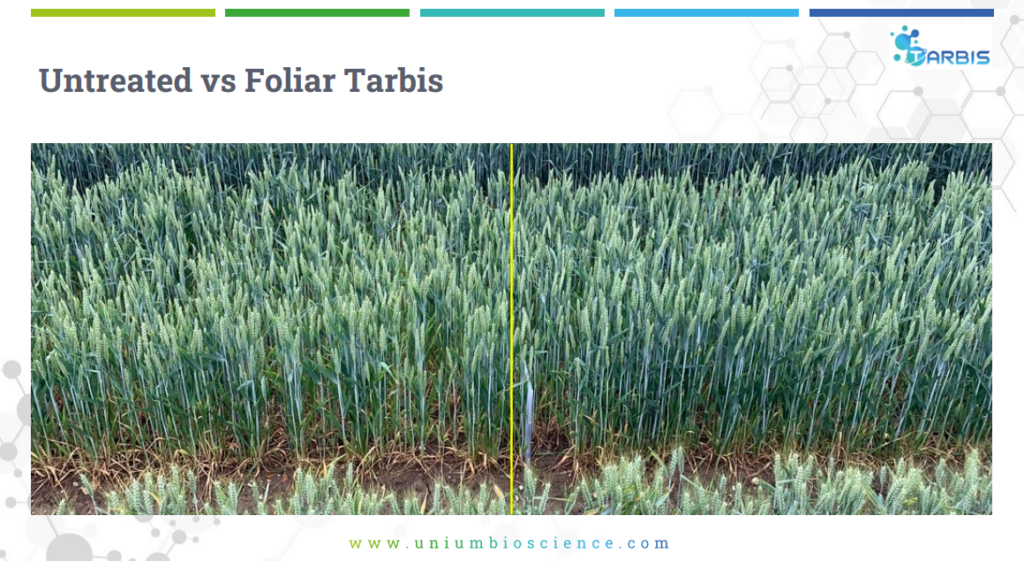
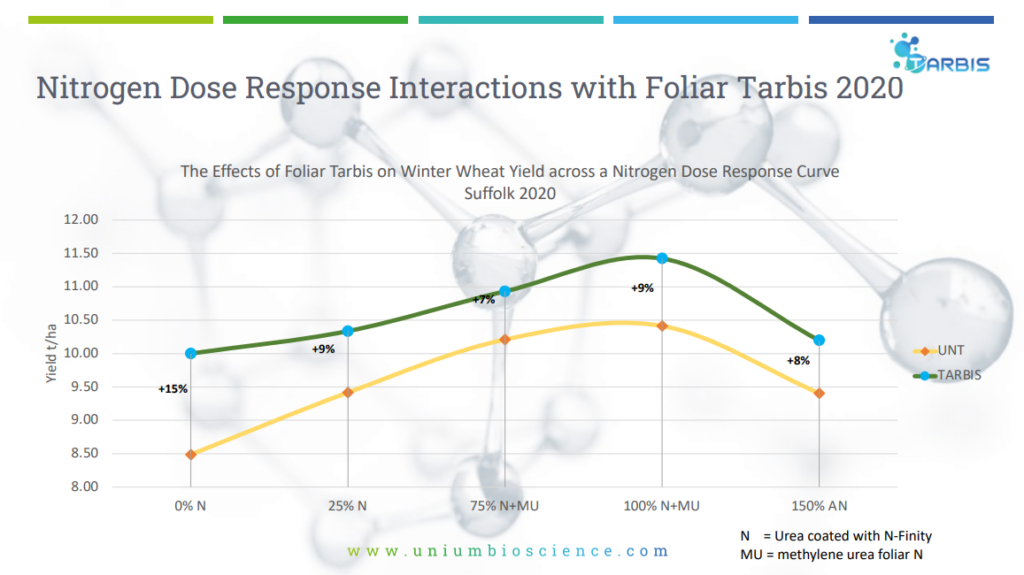
TARBIS has been tested alongside the major crop protection materials with no loss of active ingredient or effectiveness and is also approved for use in organic systems.
Unium Bioscience will be offering TARBIS across the UK in the coming months. Speak to your merchant to source it. To learn more, visit https://www.uniumbioscience.com/portfolio-items/tarbis/



-

Drill Manufacturer in Focus – Jeff Claydon
Commodity price rollercoaster is making planning difficult
Global events and extremely wet weather mean that there’s a lot to think about on the Claydon family’s arable farm in Suffolk, says Jeff Claydon, inventor of the Opti-Till® direct seeding system.
February 2024
Since the start of 2024 it has become evident that farmers all over the world have been pushed to the point where rising costs, increasing legislation and governmental pressures have left them with little choice but to make their feelings known to politicians in no uncertain terms. As I write this, it seems as if farmers everywhere are protesting. In the UK, throughout Europe and as far afield as the USA, Canada and Australia, the slogan ‘No Farmers, No Food, No Future’ is being seen everywhere.
Something is obviously and seriously wrong in terms of how those who produce the world’s food are being treated and compensated, or rather inadequately compensated for the considerable risks involved. The decision to participate in such protests is not one that is taken lightly because inevitably it involves additional cost and time spent away from the farm, which most can ill afford.
It’s not difficult for those of us in the agricultural community to understand why things have reached a head. Farmers have always done everything that politicians have asked of them in terms of increasing production to ensure that sufficient food is available to the public at affordable prices. Yet, over the last two or three decades, our industry has come under increasing pressure and criticism. In some cases that has been from a public with little or no idea of what farmers do or what is involved in producing their food, in others from transient politicians who are often ill-informed and out of touch.

This crop of oilseed rape which was drilled in August looked well at the beginning of February. With geopolitical issues, international instability and global supply issues more pronounced than they have been for a very long time, one cannot help but wonder whether politicians from all nations have become complacent over food security and don’t recognise the long-term implications of this.
Supply chain demographics have also changed markedly over the last few decades. Having recently celebrated my 70th birthday I am old enough to remember when the UK was characterised by its small farms and local, independent shops. In the 1960s and 70s one could buy almost anything from the weekly market in my local town, Bury St Edmunds. All of it was locally produced or locally sourced, but now the market is much like any other, selling products which have been brought in from who knows where. That is sad to see.
Neither has the transition from having numerous local mixed farms and mills to a handful of large feed manufacturers, food groups and intermediaries who dominate the market been good for those of us who produce food, or indeed the consumers who ultimately buy it. One can only hope that common sense will ultimately prevail, bringing a return to more local suppliers with lower overheads and a greater personal stake in their local community.

This field of Skyscraper winter wheat was drilled on 15 October before the onset of relentless rain and looked good when this photograph was taken during the second week of February. The crop was significantly more advanced than where the farm experimented with slightly deeper drilling to avoid the emerging crop potentially being affected by pre-emergence herbicides. All it needs now is some warm, dry weather. The big question for the farming industry going forward is whether we will see a major swing away from the globalists’ agenda favouring lower quality, factory-produced/artificial foods so that we can remain a nation of farmers, or will we be economically forced to become park keepers? Some farmers on less-productive land have already decided to take part of their land out of production and put it into one of the schemes currently being offered, such as the Sustainable Farming Incentive (SFI) or Biodiversity Net Gain (BNG).
At this stage it’s difficult to answer that question, but if a significant amount of productive farm land is tied up in non-productive schemes, some lasting up to 30 years, where will the nation’s food come from in the future? That should concern everyone in the UK as it will affect food availability, price and quality.

The Claydon farm continues to experiment with cover crops to assess whether they provide any benefits. Areas where cover crops were sprayed off in January contained much higher numbers of weeds and are clearly visible next to land which received multiple passes with the Claydon straw Harrow in the autumn. As farmers, we can only make our feelings known and do our bit to educate the public and make them more aware of the consequences. However, at the end of the day as business owners we must work within the framework set out by politicians, which puts us in the position of being price takers. Our primary focus must therefore be on controlling costs and generating a realistic margin, one of the many areas in which using the Claydon Opti-Till® System can help.
Prices for farming inputs are constantly rising and even though fertiliser is now half what it was a year or so ago, it’s still double what we were paying three years ago. In contrast, prices for what we produce have fallen back to little more than half what they were last year when wheat spiked to £250 – £300 per tonne, while interest rates have skyrocketed from 3% to 8%.

A close-up of the Straw Harrowed area shows that it is in excellent condition and will be ideal for drilling as soon as the weather allows. Crop prices at current levels raise the question whether, at least in some cases, they justify the financial risks involved and could capital be better employed elsewhere? Currently, on the Claydon farm we grow winter wheat, all first wheats, oilseed rape and spring oats. The former is the mainstay in economic terms, accounting for half of the cropped area, while spring oats have increasingly featured in our rotation because they spread the workload and are fantastic for cleaning up any grassweeds. Currently, we have a substantial area of oilseed rape, but given the high up-front costs and increasing potential risks involved in growing it the price needs to be at least £400/t for it to be viable.
WHAT’S HAPPENING ON THE CLAYDON FARM?
During the first week of February our weather station recorded 60mm of rain, adding to the extremely high levels of precipitation since mid-October. Even the worms which are normally evident in high numbers appear to have gone into hiding, but hopefully warmer weather will see them come out to play.
Starting on 15 October, we established the planned winter wheat area, albeit under slightly damp conditions, using our 6m Claydon Evolution M6 drill. After that went in we recorded an average 1cm of rain per day for the next three weeks. To provide some context, that’s equivalent to a staggering 2100 tonnes of water per hectare.
That much rain falling on our very heavy Hanslope series soils made it more difficult to apply post-emergence herbicides, but the firm, supportive soil structure left behind the Claydon drill meant that our self-propelled sprayer had no issues travelling and barely left a mark. However, looking at the levels of weed control in the crops earlier today it appears that prolonged adverse conditions during the autumn and winter reduced the efficacy of the products which were applied.
The very wet soils have prevented crops from developing as quickly as they should, so plants are generally quite small relative to this time last year. Once the weather improves, they will need pushing to reach their full potential.
At the time of writing (26 February) some nitrogen has been applied. We took advantage of a short weather window last week to apply 150l/ha of N35 to our oilseed rape, but in the wheat fields where we were unable to achieve good control of grassweeds it was a question of do we apply nitrogen or sort out the grassweeds first?
The rain which fell just after harvest created ideal conditions for the Claydon Straw Harrow and we carried out multiple passes across the farm. That knocked out huge numbers of weeds, volunteers and any slugs which were present in the chopped straw. In October we applied glyphosate to kill any remaining green material, but almost immediately the heavens opened.
Given the wet conditions which have prevailed since then we are currently considering our weed control strategy. I recall that in 2012, another very wet season, the weeds that we thought had been well controlled in the autumn came back with gusto due to thinner crops and chemicals not working as well as they should have.
Given the lower levels of chemical control due to adverse weather I am feel much more secure knowing that we have our 6m TerraBlade inter-row hoe to call upon. This will be used to take out weeds growing between the rows, thereby protecting yields, increasing returns and preventing weed seeds from being carried over to the following crop. Independent research shows that using the TerraBlade reduces grassweed numbers by an average of 60%, which with wheat at £200/t has improved the yield and gross margin by £257/ha.
DRILLING OSR LATE WAS UNSUCCESSFUL
Painful experiences with cabbage stem flea beetle damage in recent years have made me nervous about sowing oilseed rape immediately after harvest, so as an experiment we drilled some in mid-September. A small amount of pest damage was evident in December, but by then the crop has fallen way behind that sown in August. Despite applying Centurion Max to take out any grassweeds it looked very vulnerable, and the weak plants ultimately fell victim to wet conditions and slugs. When conditions allow this area will be redrilled with spring oats, a crop we will be growing more of this year.
Normally, 50% of the farm is into first wheats and the remainder divided equally between oilseed rape and spring oats. The reason for majoring on first wheats is to keep on top of grassweeds, and with oilseed rape at significant risk from cabbage stem flea beetle we have drilled a higher percentage of spring oats this season as part of our block rotation system.
Land destined for spring oats was Straw Harrowed up to six times during the autumn to take out germinating volunteers and weeds at the cotyledon stage. Any green material remaining was planned to be sprayed off before Christmas. Windy weather meant only 30ha were sprayed and it was 9 January before we were able to spray off the remaining 120ha. This helps to reduce the toxic effect of over-wintering blackgrass and the land rested over the winter. Another dose of glyphosate will go on just before drilling.
As soon as the weather allows, we will drill the spring oats, any surface compaction caused by the extended wet weather being removed by the leading tines on our 6m Evolution drill. It will be interesting to see how those areas where we grew cover crops perform, and whether there is a sufficient increase in yield to justify the significant cost of growing them. The jury is still out on that one.
The exceptionally wet weather has also highlighted small areas of fields where drainage is sub-optimal. The leading tines on our drill are enormously beneficial in terms of allowing water to move from the surface down through the soil, but in some areas the laterals have been at capacity and unable to take any more water. We have identified areas where drains have reached the end of their working life, and others where more capacity is needed so, conditions allowing, we will install those new drains and mole other areas after harvest.
With the dark, wet days of winter hopefully behind us, spring should be a period for optimism, so I’m looking forward to some warm, dry weather to get crops growing and ensure that they develop their full potential.
On a final note, I would like to thank the Suffolk Farming and Wildlife Advisory Group for presenting Claydon with their Peewit Award for Excellence in Ecological Farming. I was delighted to be presented with the award at their annual presentation event in January, an event made even more special because my sons Oliver (Claydon’s Operations Director) and Spencer (Commercial Director) were there with me to share the experience.
The Claydon website (claydondrill.com) galleries contain numerous videos on soil health and resilience, as well as showing the Claydon Opti-Till® System being used to establish all types of crops, in all situations, both in the UK and overseas. You can also keep up with the latest posts, photographs, and videos from Claydon and its customers through the Claydon Facebook page www.facebook.com/Claydondrill
Claydon wins prestigious ecological excellence award

The Suffolk Farming and Wildlife Advisory Group’s 2023 Peewit Award
for Excellence in Ecological Farming.
Claydon’s achievements in designing and manufacturing machinery which enables farming businesses to implement crop establishment solutions which are commercially and ecologically sustainable has been recognised by the Suffolk Farming and Wildlife Advisory Group (SFWAG).
Anna Beames, Chief Executive of SFWAG stated: “At a time when so much discussion is taking place about the environmental issues which are impacting the world it is very pleasing to note that where farming was once regarded as a major part of the problem it is now rightly recognised as a key part of the solution. This was confirmed at the recent COP28 summit in Dubai, where global leaders acknowledged the profound potential of agriculture and food systems to drive powerful, innovative responses to climate change.
“The Suffolk Farming and Wildlife Advisory Group was born from farmers with a deep understanding of integrated farming which considers both the environment and wildlife, so we are keen to recognise those who actively seek to reduce the industry’s environmental impact. Our annual awards highlight exceptional examples of ecologically sustainable agriculture which restore, protect and create high levels of Natural Capital to deliver ‘public goods’ whilst profitably producing healthy, nutritional food.
“Our theme for 2023 was ‘Sustainable Farm Solutions’ and Claydon is an extraordinary example of that. Because of that we were delighted to round off Suffolk FWAG’s series of farm walks last year with a visit to the Claydon’s arable farm at Wickhambrook in Suffolk. The farm has been in the Claydon family for nearly 100 years, with Jeff and his brother Frank farming there for more than 50 of those years; during which time the business has grown from 100ha to 250ha, plus 90ha which is contract farmed and some contracting.
“Soils are the farming industry’s greatest asset, yet many have been degraded to a point where now they merely provide a growing medium which depends on high levels of artificial inputs to maintain productivity. Jeff addressed this key issue more than two decades ago by developing the Claydon Opti-Till® System, a holistic approach to crop establishment which delivers consistent, high-yielding crops at low cost for maximum profitability. Crucially, it also enables farmers to become more ecologically sustainable.
“During our visit to the Claydon farm we were able to see the massive improvements which this approach has brought about over the last 22 years, including high numbers of worms and staggering levels of soil organic matter. Worms may not be sexy, but they are the unsung heroes of the farming world and instrumental in changing soils for the better, so as one of their greatest exponents Jeff is a deserving winner of the Suffolk FWAG 2023 Peewit Award.”
SECURING THE FUTURE
Jeff Claydon developed the Opti-Till® System in 2002 to reduce production costs without adversely impacting output, thereby securing the economic future of his family’s farm. Combining well-proven stubble management and direct seeding techniques, it enables farming businesses to operate much more efficiently, profitably, and sustainably.
Since launching its first drill in 2003, Claydon has relentlessly promoted the importance of excellent soil health and raised awareness of how to improve it. With more frequent extremes of weather, Opti-Till® is particularly relevant because it is effective in all conditions, minimises risk and provides sufficient capacity to exploit narrow weather windows. This allows all agricultural seeds which can be air-sown, from herbs and grasses to cereals and maize, to be drilled at the right time, in the right conditions and ultimately produce the high yields required to make farming businesses more weather and financially resilient.
Unlike many other companies in the UK farm machinery sector which import machinery made overseas, Claydon designs, tests and manufactures all its products from scratch, employs local staff and sources materials from UK suppliers.
Versatile, reliable, with a low power requirement and ownership costs, Claydon Evolution and Hybrid drills, Straw Harrows, TerraStar® light cultivators and TerraBlade inter-row hoes are manufactured to exceptionally high standards at the company’s factory in Wickhambrook, Suffolk, which employs over 70 staff.
European market leader in direct seeding technology, Claydon has seen demand for its products grow ten-fold since 2010. During 2023 the company experienced significant growth in sales as the business worked closely with its dealer and distributor partners in existing and new markets. With many markets still at an embryonic stage and its distribution network growing rapidly the company expects sales to continue increasing during 2024.



-

Farmer Focus – John Farrington
No one wants to talk about the recent weather over the last 5-6 months, in summary it has been bloody awful and relentless for farmers and non-farmers alike and I expect most farm records have all been smashed for the wrong reasons. The topic and the big consequences that farmers have endured and suffered has certainly been one way to get people feeling pretty down, with plenty of stress and worry added into the job.
It has been good to get off farm and visit a couple of other farms over the last month or so; I visited David White and Ben Martin in Cambridgeshire and Regen Ben in Herefordshire. It was great to get off farm for the day with a change of scene and see what others are up to. You always come back with ideas, possible improvements you can implement and confidence that others are making it work, so crack on and have a go. It is great for your mind to have a break from the home farm and chat to others, so I encourage you to all get off your own farm for a day, whether that be visiting another farmer or spending the day with the family, it will lift your spirits.
With our sheep enterprise we are part of a beef and sheep grazing group and we hosted the Southwest late winter farm walk. (it certainly wasn’t early spring!!) We are only coming into our 3rd season with sheep on the farm, so it was great to show some more experienced minds what we get up to and get some external feedback. The day was led by James Daniel, from Precision Grazing, who has been brilliant in helping my brother, Charlie, get the sheep enterprise set up. There were plenty of interesting discussions in the shed (to keep dry) and then out in the field visiting herbal leys, cover crops, arable reversion and ewes in a field of muddy turnips. We took a lot away from the day and found it very useful.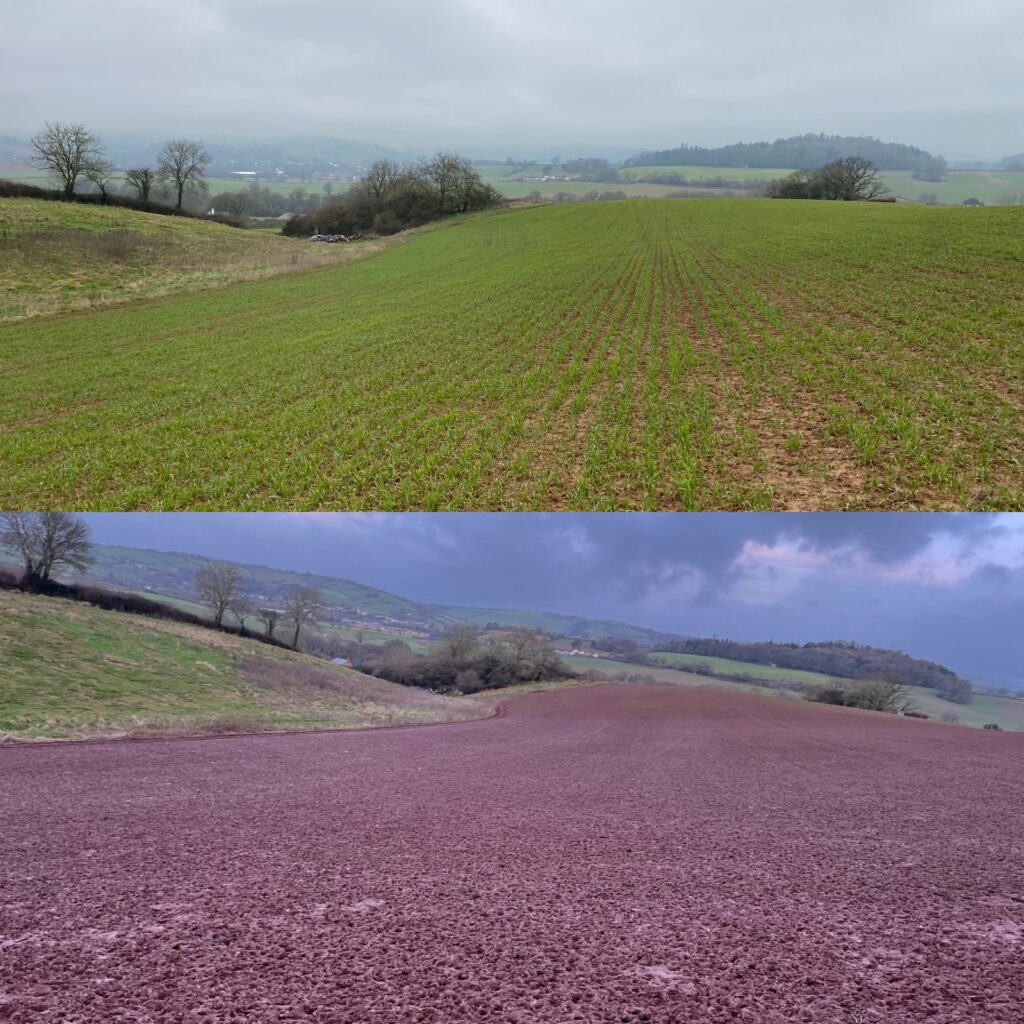
Top of picture 6th March, Bottom of picture 22nd January after sheep grazing, taken from same spot. We have started a straw for muck arrangement with a neighbour, he bales and hauls the straw behind the combine at harvest, we then put 2 tractors and trailers on when he is clearing out the sheds during the winter, he loads with his handler. There is no money changing hands, but they are roughly counting bales into the cattle shed when bedding up. It has worked well so far, even though it has been very wet we have not made too much mess considering the rainfall… One trailer is on flotation tyres and the other is on super singles. One hardly leaves a mark and the other leaves a nice rut when loaded (this trailer is borrowed) so amazing to see the benefit of flotations.
It will be spread on growing wheat (all of which has been grazed during Jan/Feb) if the ground conditions allow and the rest will be going on in front of maize. We have had the FYM analysed and now just working out the rates per Ha. A good load or two an acre should do!!
The wheat is generally ok after the horrendous weather, some heavier areas and odd headlands of fields have not survived and will need to be dealt with in the spring. Grazing the wheat has been closely managed with the sheep moving every 2-3 days so they don’t make a mess…..other than one Sunday evening when a storm and heavy rain came through!! I thought someone had been out with the plough overnight when we checked them Monday 7am. You would not be able to spot that area from the rest of the field now. See pictures. This is not our normal practice; it will be a good on farm trial.
One of the big farming buzz words flying around is “SFI”. We have recently spent time in the office going through the various options available in addition to our Mid-Tier agreement. I have spoken to a few farmers who don’t want to be involved and can’t see the benefit, but for us and the way we are farming it is a no brainer and it will benefit the business. We are doing quite a lot of the options already off our own back so the payment is a welcome bonus. We are certainly not putting the whole farm down to SFI and stopping farming. We will be integrating SFI into the farm business to compliment what we are already doing on the arable, sheep and environmental sides of the business and the extra income (including taking account of income foregone) will certainly help the bottom line with BPS reducing rapidly.
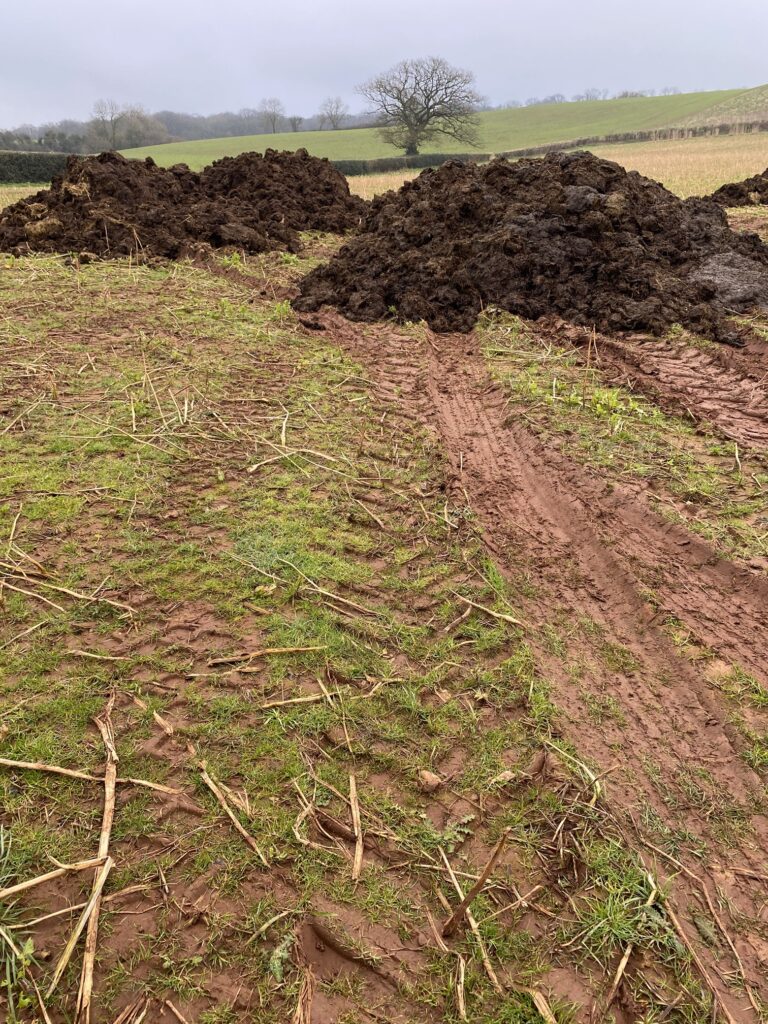
Flotation tyre on left, super single on right Last summer we started a project that had been simmering in my mind for a number of years. The council lane that leads into our main farmyard has got very poor access, sharp bends, neighbours, narrow width, fields either side higher than the road, so altering the existing lane on a dark winters night when no one was looking was not an option. We could only take a rigid lorry, no artics, the combine and large machines had to go along a soil track through a number of fields. Planning permission was approved and work started to open up a new access out onto the road, a site for a shed, and a track leading down to the farm to bypass the council lane. It is one of those projects you wish you had done 10 years ago. It was a fantastic feeling when we had the first artic grain lorry arrive at the farm in the autumn, and not having to worry what size lorry the deliveries were coming on. Never under estimate how much soil there is to move when you start digging, we certainly did !!
Now we are a mixed farm rather than straight arable, we can and need to be more flexible on cropping rotation etc. We have persevered with under performing arable fields for a while now and these wet years have highlighted this even more, so now we have got the sheep we have decided to take them out of arable and put them down with herbal ley and make better use of them, they will hopefully be in a better state when arable crops return to them in 4-5 years’ time. We don’t necessarily need the extra grass around in May time when the herbal ley will be at its most productive, so we are planning to sell a 1st cut of silage to a neighbour to get the main bulk away and then we can make use out of it for the rest of the year with the ewes and lambs. It will also mean that the lambing paddocks can have a good rest from sheep to help with grass recovery rest period and any worm burdens that might have built up during lambing. Once the silage has been cut, within a couple of weeks we will then have lovely fresh grazing for the lambs all through summer and autumn.
I hope the weather improves so we can all get back on the land and make some progress, a bit of sun will also lift the spirits of everyone. Its amazing just what a couple of sunny days can do.


-
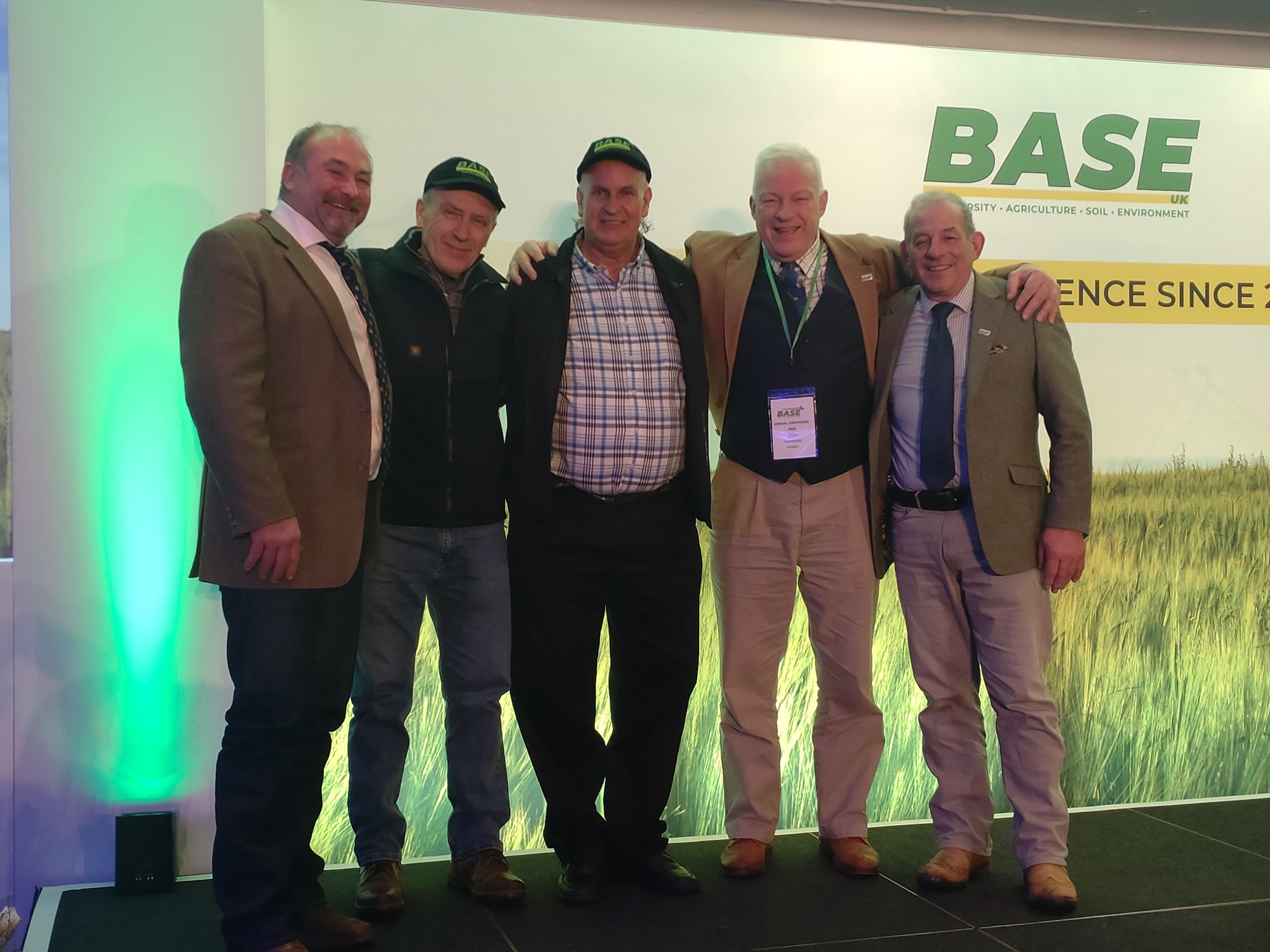
BASE-UK – Conference 2024 – Learning from Experience!
International expertise, as well as UK-based knowledge and practical experience, was on the agenda at this year’s BASE-UK conference, which took place in Nottingham in early February. A wide variety of topics were covered over the two days, from soil health, cover cropping and intercropping, to integrating livestock and the nutrient density of our food.
There was also an insight into Landscape Enterprise Networks (LENS) – a network of commercial organisations seeking outcomes from the farmed environment in return for payment for the implementation of agreed practices.
The conference kicked off with Dr Ademir Calegari from Brazil, who shared his 47 years of experience with cover crops with great energy and enthusiasm. He emphasised the importance of cover cropping in a sustainable farming system, with its contribution to soil carbon from root exudates, soil surface cover, soil aggregation, soil stability and water handling/storage.
While much of his work has taken place in South America, in crops such as coffee, sugar cane and soya, Ademir applied the principles of feeding the soil to feed the crop more widely.
The messages for BASE-UK members were to find the right cover crop solutions for their particular farm problems or constraints, to make best use of multi-species cover crop mixes to bioactivate the soil and to exploit the nutrient cycling benefits that cover crops provide. “If you get this right, the soil will feed the crop. And if you add livestock to the system, the results are almost unbelievable,” he said.
The first day also saw David Purdy give an update on the work done at Project Lamport, where heavy high magnesium soils present their own challenges and a long-term approach to building resilience into the system has been taken.
He was followed by first generation organic farmer Alex Fraser, who combines running a new farming business with his work as an A&E doctor in Yorkshire. He outlined progress to date and was honest about the challenges he has encountered as a new entrant.
The last two speakers were farmer members, Toby Simpson, and Ben Adams. Toby reported on the findings from his Nuffield scholarship on catch and cover cropping opportunities while Ben gave an update on his three-year intercropping trial.
The second day began with soil health guru, Jay Fuhrer (see panel), who’s reputation precedes him. His presentation on moving the carbon dial was very well received by members.
Next up was Northamptonshire farmer David Goodwin, who spoke about how he had integrated livestock into an established arable business, outlining the barriers as well as the benefits.
Richard Jenner of Openfield then gave an update on LENS, explaining that it is just one of a suite of natural capital income streams for farmers. “Every farming business is different and there is no right or wrong model,” he stressed. “Farmers have the option to do nothing when it comes to natural capital opportunities, or they can implement the SFI, trade carbon, get rewarded for insetting carbon reductions in the supply chain or provide ecosystem services to a network, such as LENS.” Most will opt for a hybrid approach, he predicted.
The last speaker was Dr Hannah Fraser, a Nuffield scholar and wife of Alex. Hannah updated the conference on her findings on the role of farming in providing nutrient dense food, emphasising that the way we farm impacts nutritional quality. Against a backdrop of declining life expectancy in the UK, Hannah’s message was that a healthy soil is the starting point for better foodstuffs.
Panel – Jay Fuhrer
Soil carbon levels can be moved in the right direction by applying a set of five soil health principles, US-based international soils expert Jay Fuhrer told the conference on the second morning.
Putting carbon back into soil helps with its ability to cope with future climate challenges by improving its resilience, he said, giving it a more stable structure and helping with water retention and infiltration, as well as making it less prone to erosion, increasing biological activity and improving its nutrient supply characteristics. “That’s why farmers who increase soil organic carbon have better soil health.”
Old Sunshine
Jay pointed out that soil organic matter was built long ago when there was abundant plant diversity with numerous species and large populations of herbivores. Having many species growing meant that the soils used to get root exudates from a diversity of plants, which fed the soil microbes and resulted in soil aggregates being built.
In contrast, today’s cropping systems based on monocultures can’t build soils in the same way, as the soil biology receives exudates from just one annual plant at a time, he added. “Soil carbon has been lost by agricultural systems which took this species complexity away in the drive to become more efficient. Carbon leaves the field in the grain, so unless you are taking action to slow these losses and put carbon back into the ground, you are going to keep on degrading your soils,” he warned.
New Sunshine
Jay said that farmers can use new sunshine to drive biological carbon capture, by harnessing plant diversity and using animals to do some of the decomposition or recycling required. Carbon enters the soil as living, dead and decaying material, and the nature of soil carbon means that farmers need to appreciate the role played by plants and the importance of cover crops, he adds.
“The exudates they give off are consumed by soil microbes, which build aggregates and make the glue that helps to limit soil erosion and get water and oxygen into the soil.”
Put into a system, they mimic the scenarios from years ago, eventually helping to restore landscapes and build back what’s been lost. He likened the process to accelerating biological time – as it shortens the window in which change can take place. “Multi-species cover crops make something happen in a shorter time period than if there had been monocultures there.”
Five Soil Health Principles
Jay Fuhrer emphasised that these are principles, not practices, which can be used in a systems approach.
- Provide Soil Armour/Cover
- Minimise Soil Disturbance
- Include Plant Diversity
- Maintain Living Roots/Plants
- Integrate Livestock


